
She sued the General Assembly pg.3
She’s the winningest head coach pg.16



March 6, 2024
She’s the first African American woman tenured professor pg.4
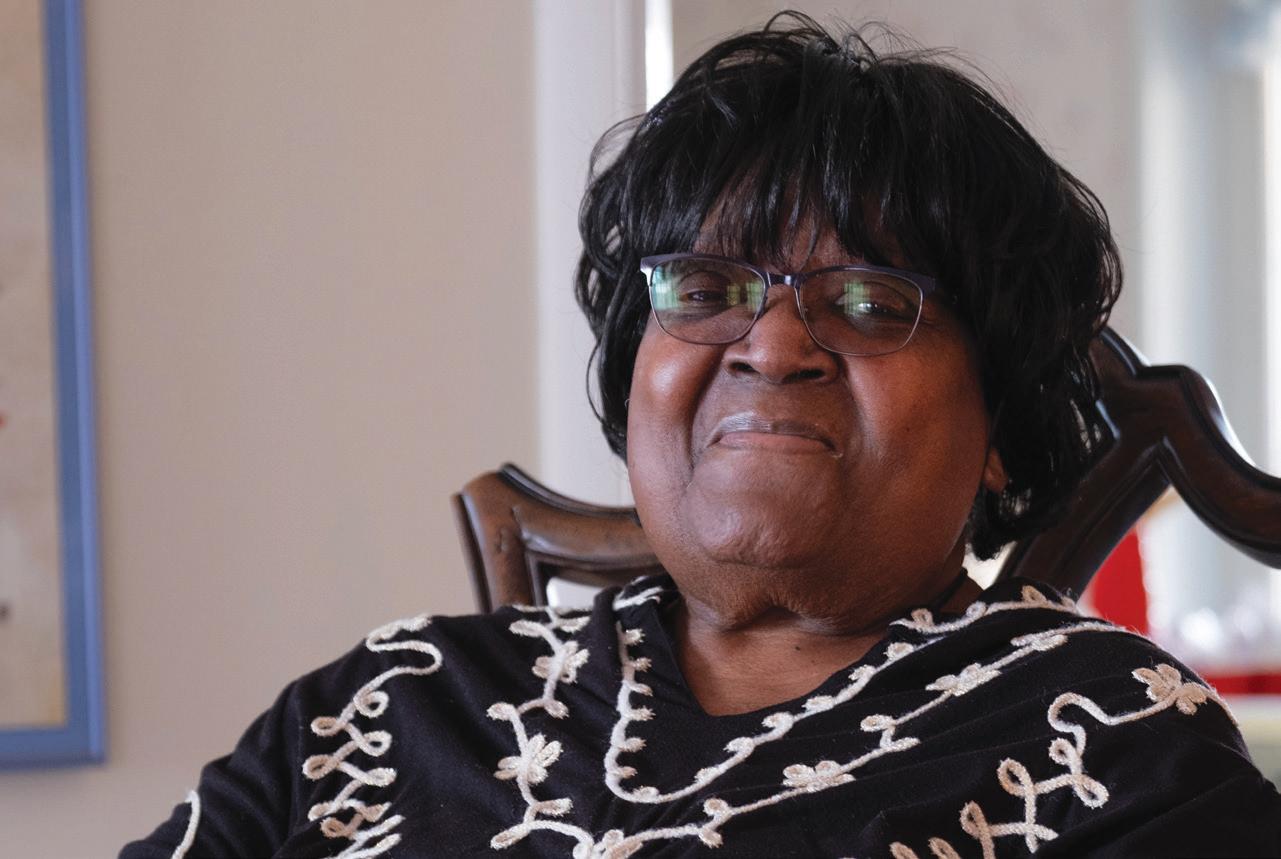

pg.10-11
She’s a memeber of the Haus of Liqueur, a local drag group
Photo by Taylor Ward
Photo by Mayesivy Carlson
Photo by Hayden Wittenborn
Photo by Leah Matney
@THEAPPALACHIAN | THEAPPALACHIANONLINE.COM
Jenna Guzman, Editor-in-Chief editor@theappalachianonline.com
Business
Los Angeles Times Sunday Crossword Puzzle
“CON TEST” BY BRIAN THOMAS & KATE CHIN PARK
ACROSS
90 Spousal term of endearment
92 Toss, slangily
93 Performed miserably
Edited by Patti Varol
130 Greek vowel DOWN
1 Tennis great Steffi
19 Major drama
20 Two bars and two dots, on a staff
23 Actor Hardy
53 Tear it up
55 Unleash
56 Spunk
58 Many an Argentine red
91 “__ outta here!”
94 Skywalker mentor
96 GameCube successor
Ella Adams, Managing Editor
Vivian Parks, Chief Copy Editor
Siri Patterson, News Editor
Madalyn Edwards, Assoc. News Editor
Briley Turpin, A&C Editor
Abby Buckner, Assoc. A&C Editor
Leah Boone Opinion Editor
Bella Lantz Assoc. Opinion Editor
Ethan Smith, Sports Editor
Chance Chamberlain, Assoc. Sports Editor
Mia Seligman, Enterprise Editor
Editorial Visual
K. Slade, Visual Managing Editor
Pruett Norris, Multimedia Editor
Ashton Woodruff, Photo Editor
Emily Simpson Assoc. Photo Editor
Kaitlyn Close, Graphics Editor
Rian Hughes, Assoc. Graphics Editor
Ethan Batchelor, Business Manager
Kayla Masterman, Distribution Manager business@theappalachianonline.com
Marketing
Julia Woodring Director of Marketing/PR
Chloe Jenkins, Assoc. Director of Marketing/PR
Ella Wilson, Director of Audience Engagement
Dr. Allison Bennett Dyche, Adviser adviser@theappalachianonline.com
The Appalachian is the award-winning, independent student-run news organization at Appalachian State University, published since 1934. The student staff maintains all editorial discretion, and there is no prior review by university faculty, staff or administrators. The Appalachian strives for accuracy in newsgathering and reporting. If you think we have made an error, email: editor@theappalachianonline.com
Participation in The Appalachian is open to all current full-time students at the university. For more information about joining, email: outreach@theappalachianonline.com
The opinion pages of The Appalachian are open public forum.
Contributions are welcomed via email to editor@theappalachianonline.com. Opinions expressed are those of individual columnists, and do not necessarily reflect the views of the news organization overall. Unsigned editorials represent the collective opinion of The Appalachian editorial board. One copy of The Appalachian per person. Additional copies can be purchased from the newsroom for $1 each.
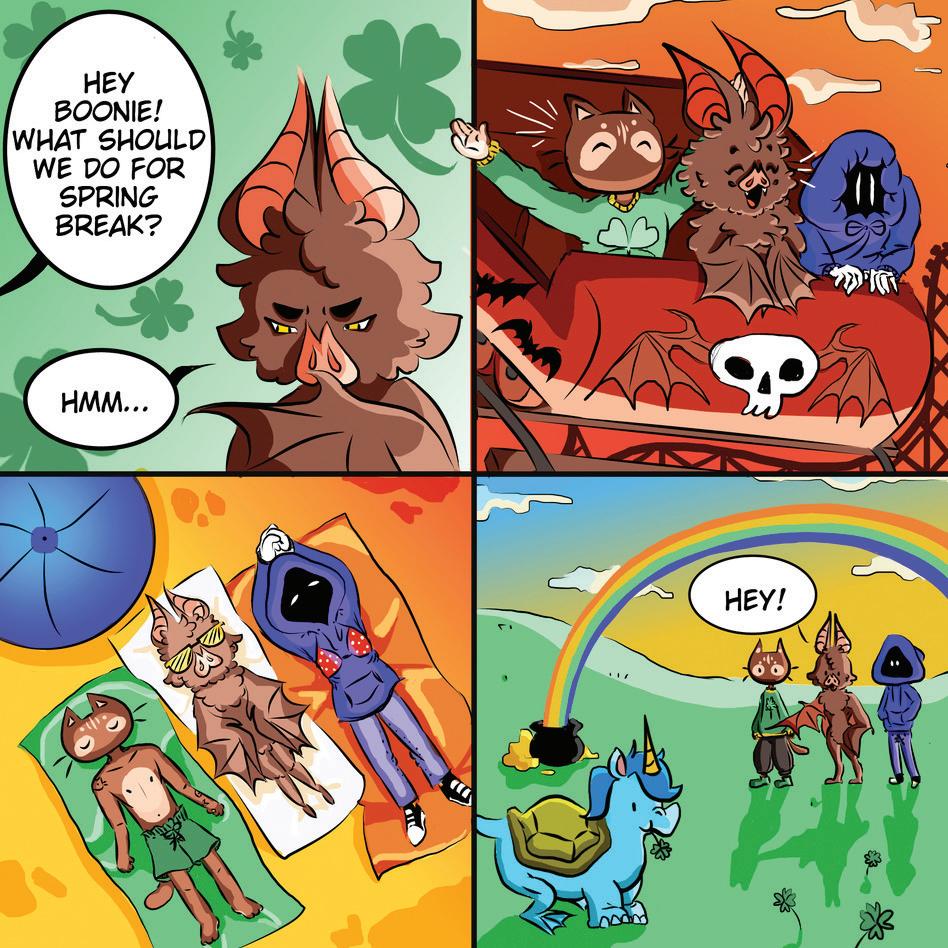
1 Handy smartphone app for a tourist
4 Most pancakes
9 Ijeoma Oluo’s “So You Want To Talk About __”
13 Lumps in a stack of folded sweatshirts
18 Make a big fuss
20 Auburn, to Alabama
21 Skerry, e.g.
22 Con current?
24 Bradbury genre
25 Brotherly sort
26 Blackpink genre
27 December quaff
29 River near Shakespeare’s birthplace
30 Argentine grassland
33 Con tour?
37 Con quest?
41 Hardly any
42 Squeaky toy?
43 With 52-Across, some midriffbaring attire
44 “Star Trek: TNG” counselor Deanna
45 Leg bone
47 System connecting OAK and SFO
50 Patella spots
52 See 43-Across
54 Con sorts?
57 Plays chords, in a way
59 Aristotle’s teacher
61 Fictional Amelia who, when asked to remove spots from a dress, cut out all the polka dots
62 Maui’s Road to __
63 Iranian money
64 Chart-topper
65 “Shucks!”
66 “Black-ish” dad
68 Con note?
73 Tic-tac-toe side
74 Slitherers in the sea
76 Freedom Rider’s ride
77 Scuffle
78 As concerns
80 Code names
82 “See what I did there?”
84 Drives too fast
86 Con text?
88 Half of quatorze
95 Put pen to paper
97 “Aida” river
98 Classic film about a footballkicking mule
100 Swing about
101 Con figure?
103 Con script?
108 False move
109 Capital of Italia
110 Lacking freshness
111 “ ... __ I thought”
113 Saint-Saëns’s “__ Macabre”
117 Conscious
119 Con form?
124 Seeds, weeds, and feeds
125 Asteroids publisher
126 “Wait, what happened?”
127 Come up
128 Nave-y bases?
129 “Divine Comedy” poet
2 Skating team
3 iPhone speaker
4 Reorganize a hard drive, familiarly
5 Cocktail sphere
6 “Yakety __”: horn-heavy novelty hit
7 Algonquianspeaking people
8 Manicure sound
9 Salt garnish locale
10 Letters after Madison or before Maria
11 Source of hemp
12 John who completed an EGOT in 2024 13 That fella’s
14 Name on a Wienermobile
15 Tapenade fruit 16 Crusoe’s creator
17 Stay
28 Macroeconomics abbr.
31 Actor born Laurence Tureaud
32 Components
34 Proclamation
35 Hasbro’s “game of unspeakable fun”
36 Turn
37 “Cathy” cry
38 Vessels in a pharaoh’s tomb
39 Follow the rules
40 1960s nonconformist
46 HS exam with a cellular energetics section
48 Dadcore jeans specification
49 Lacking freshness
51 Olympic gold medalist Lee
60 Up in the air
63 Campground sights, briefly
64 Rte. 66, e.g.
66 The “D” of CODA
67 Baton-passing event
69 Boots
70 Novelist Leon
71 Like the Resident Evil games
72 Had more than an inkling
75 Rails against failure?
79 Put back
81 Crunch cousin
82 Actor Elliott
83 Jaded feeling
84 Big name in Apple history
85 Ward of “Gone Girl”
87 “See you then!”
89 As per routine
99 Cheap ticket spec
102 Final application
103 Persona non __
104 Scull mover
105 Bahla Fort visitor, perhaps
106 Yosemite peak free soloed in “Free Solo,” informally
107 Miracle-__
112 Came out with
114 Vertex, in graph theory
115 Clubs, but not cabarets
116 Jazz singer Jones
118 Kampala-toNairobi dir.
120 Unedited, as footage
121 OBs, e.g.
122 Racket
123 Chicago winter hrs.
2
RELEASE DATE—Sunday, March 10, 2024
ANSWER TO TODAY’S PUZZLE 3/10/24 ©2024 Tribune Content Agency, LLC. Answers on page 6
| contact
games
Comic by Yakira Gurganus
&
Andrew Rice | News Reporter
Meet Sophie Mead: The student who SUED the General Assembly
When Sophie Mead walked into Plemmons Student Union to vote in the primary election on Feb. 19, she said she had a new perspective.
She showed her ID to the poll worker, double-checking her personal information when receiving her ballot.
“As I’m going to vote, I’m looking at everything very closely and making sure my address is right, my date of birth is right, my name is spelled right,” Mead said.
Mead, a senior digital marketing major, knew these were important things to do, but she views them differently after suing the North Carolina General Assembly in October 2023.
A local citizen with no connection to her, Mead said, challenged her ballot in the 2022 general election.
According to the North Carolina State Board of Elections, challenges to voter ballots are most often based on false or misleading information provided in a voter’s registration. The challenge to Mead’s ballot was cited as a misrepresentation of address.
Mead said she used same-day registration during the early voting period in October 2022 when the poll worker handling her ballot made a clerical error under the address section of Mead’s registration form.
This error caused the Watauga County Board of Elections to flag Mead’s ballot when it delivered voter registration cards.
The Watauga County Voting Rights Task Force is a local group that conducts surveys and informs people about upcoming elections, according to its website. Mead has volunteered with the task force since 2020.
Members of the task force contact voters with challenged ballots in the county throughout the early voting period until the county board of elections certifies results 10 days after Election Day. The task force does this for every election in the county.
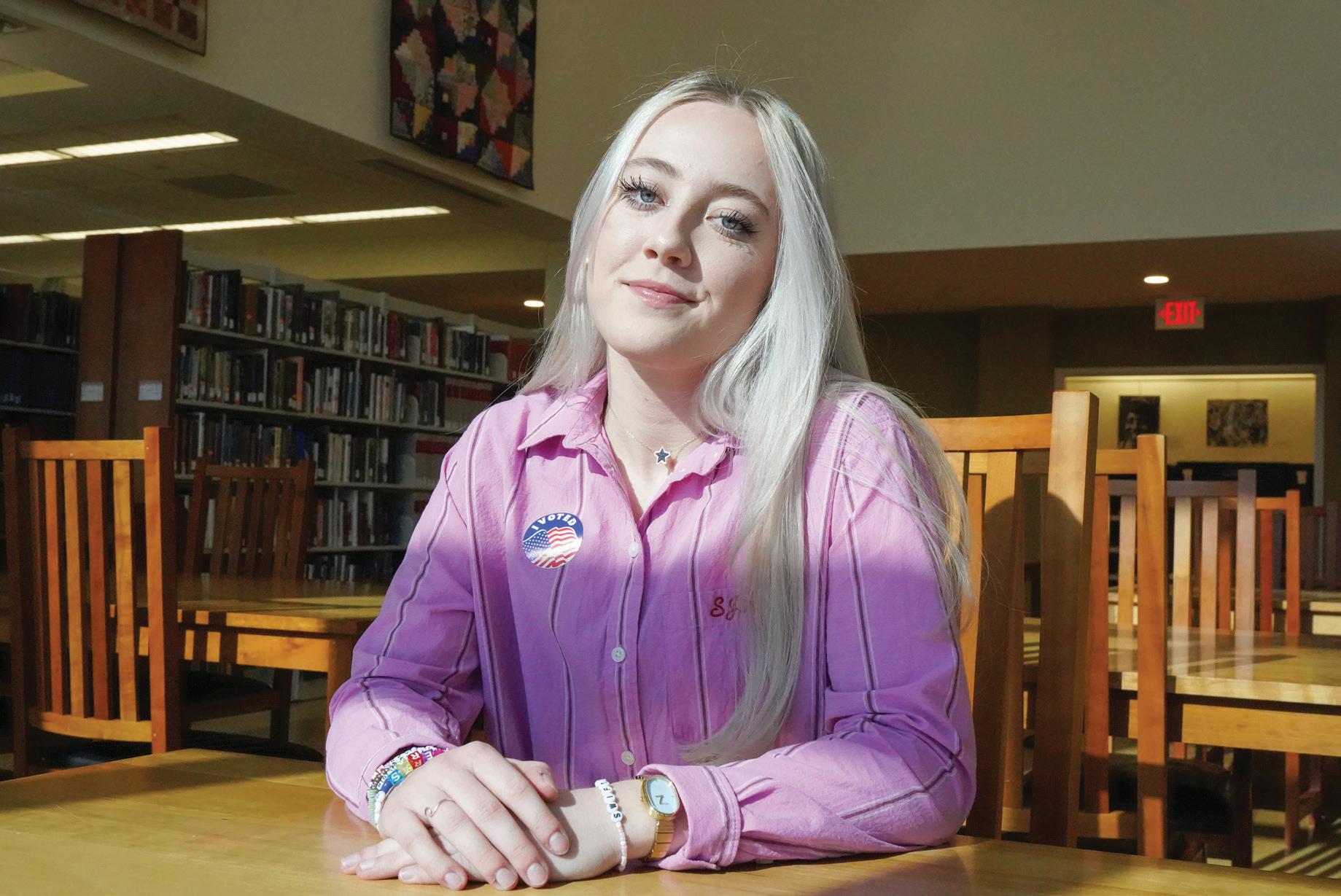
Being familiar with the process and having made the calls several times herself, Mead said she was shocked when she received a call.
Mead said she would not have known her vote was being challenged unless she had her task force coworker’s number saved.
“Had it not been somebody I knew because of my involvement, I probably would have not answered the phone call and would have never known that my vote was being challenged,” Mead said.
Mead was able to reinstate her ballot after being notified of the error and had her ballot restored into the vote totals.
Stella Anderson is a volunteer with the Watauga County Voting Rights Task Force and a former member of the Watauga County Board of Elections who represented the task
force in the lawsuit as a plaintiff.
Anderson said although Mead’s original ballot stands, it will serve as a precedent for voter suppression in light of the passing of North Carolina Senate Bill 747, a new piece of legislation that makes multiple changes to election laws in North Carolina.
Among these changes is a provision to strike down a voter’s registration and pull voter’s ballots on a caseby-case basis for future elections if a mistake similar to the one made on Mead’s ballot were to occur.
This measure would immediately remove a voter’s ballot from the vote totals without a provision to reinstate the validity of the ballot, Anderson said.
“You are going to be disenfranchised, and there will be no question about it,” Anderson said.
The law passed after the North
Carolina legislature overrode Gov. Roy Cooper’s veto on Oct. 10.
“This attack has nothing to do with election security and everything to do with keeping and gaining power,” Cooper said in a video posted to YouTube after he vetoed the bill in August.
Mead’s attorneys filed the suit on behalf of Mead, the voting rights task force, and other voting rights organizations on Oct. 10, shortly after the legislature overrode Cooper’s veto.
Mead said she is particularly concerned about the automatic removal of ballots as part of the new law because of the thin margin of votes between candidates in the 2022 election.
According to 2022 general election records from the Watauga County Board of Elections, the race for District 3 of the County Board of
Commissioners came close.
Republican Braxton Eggers and incumbent Democrat Billy Kennedy’s race came down to six votes, which triggered an automatic recount where Eggers won the seat by the same margin of votes.
“If mine, or any other challenged vote didn’t count, it could have been a very different outcome,” Mead said.
Mead said she wished the county board of elections would step in to notify voters of challenges made to their ballots.
Michael Behrent, chair of the Watauga County Board of Elections, said the board functions to monitor the election process, not to intervene.
“It’s really kind of a citizen’s oversight board for the work of the elections staff,” Behrent said.
Mead, one of two individual plaintiffs in the lawsuit, said being involved with so many large entities in the lawsuit was intimidating but believes it is important for others to know what can happen to their ballots.
“I am your average student, where I move a lot, and same-day registration is important for me, and I will rely on that in the next coming years as I continue to move,” Mead said.
Mead said she encourages voters to reach out to the task force if they have questions or find themselves in a situation like hers.
“We will serve as a guide for them and help them figure it out,” Mead said. “That’s what happened with me and eventually my vote was able to end up counting.”
On Jan. 21, a court temporarily blocked the provision Mead challenged.
3
Read more Online: news |
Senior Sophie Mead sits inside Belk Library’s Special Collections Research Center Feb. 21. Mead is a passionate voter who sued the North Carolina General Assembly after her vote was challenged. Photo by Taylor Ward
‘I view her as a role model’: App State’s first
African American woman tenured professor
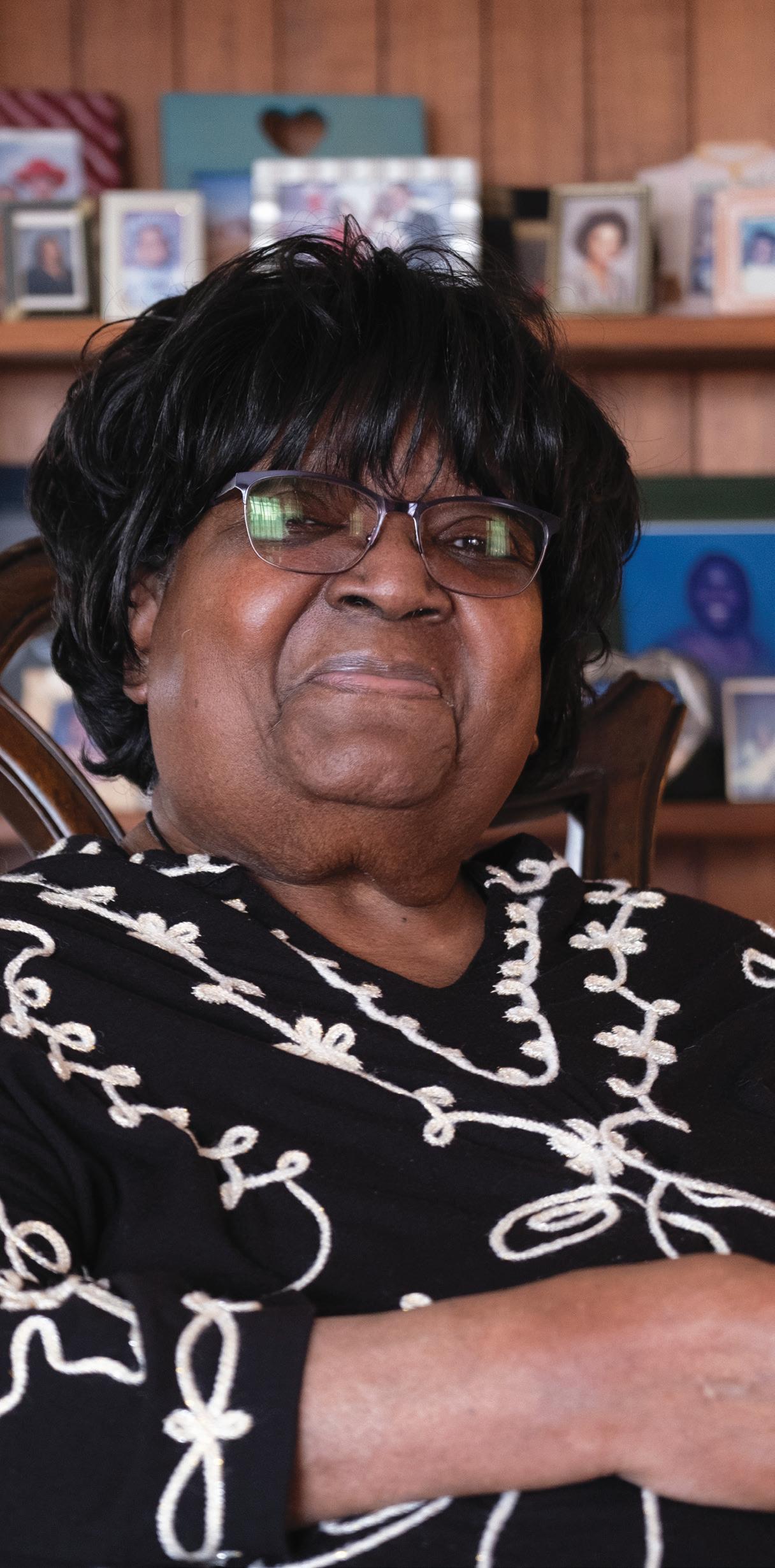 Adrianna Rice | News Reporter
Adrianna Rice | News Reporter
In June 1997, nearly 100 years after App State’s founding, the first African American woman became a fulltenured professor at App State.
During Thalia Coleman’s time at App State, she recruited many students and was a mentor to many others. Coleman worked in the Department of Communication Sciences and Disorders at App State.
Coleman grew up in a small community in South Carolina where, at the time of living there, the population was less than 1,000.
She completed her undergraduate degree at South Carolina State University. She then went to Penn State for graduate school and studied to be a speech-language pathologist with the goal of working in public schools.
Coleman had never dreamt about being a professor. After accepting a full scholarship to Penn State and earning her master’s degree, she wrote to her department chair asking for any openings in public schools. That is when the chair sent her an application to work at Penn State in the university setting.
Coleman worked at Penn State for a total of 21 years. During that time, she studied to earn her Ph.D. in Communication Processes and Disorders at the University of Florida.
Coming to App State was like a complete flip compared to her alma mater, which is an HBCU, and Penn State where she earned her speechlanguage pathology degree.
“My alma mater was an HBCU so it was a totally different cultural climate, and almost all the other professors back in South Carolina were African American,” Coleman said.
She has taught a variety of courses at undergraduate and graduate levels at App State. After earning her doctorate, Coleman taught courses mostly in child language development
and disorders. She also specializes in culturally appropriate clinical interventions.
“I enjoyed teaching and so I wanted to teach others to go out and do the things in the profession that I enjoyed when I was doing it,” Coleman said.
App State celebrates her contributions to the field of speechlanguage pathology through a scholarship given in Coleman’s name.
The scholarship was established in 2020, a few years after Coleman retired from App State.
She retired from App State in 2015 after having trained and mentored graduate and undergraduate students in speech-language pathology for over four decades.
Angela McLeod, a clinical associate professor of speech-language pathology at the University of South Carolina, met Coleman 30 years ago when McLeod was enrolled as a master’s degree student in communication disorders at App State.
“Meeting her and having the opportunity of her mentorship while I was pursuing my degree in speechlanguage pathology served as the foundation that ultimately influenced me to return to graduate school after working seven years professionally as a speech-language pathologist and pursue my doctorate,” McLeod wrote in an email.
McLeod said she has vivid
related to cultural and linguistic diversity.
“I view her as a role model, and even as I have engaged my students over the past 20 years, I think of the nurturing and support she always provided to students,” McLeod said.
McLeod saw that students were able to easily approach Coleman. McLeod said Coleman was always willing to lend an ear during stressful times; she aimed to help students work through their difficult situations so they could maintain their success.
“I recall her many efforts to recruit and maintain African American and other students of color in her department,” said Willie Fleming, a retired App State chief diversity.
“She mentored students in a holistic manner.”
Fleming sees Coleman as a friend, not just as a colleague and said he admires Coleman’s consistency in high character.
“She was concerned about the whole person and made certain those students knew they belonged at the university and in their respective department as full-blown participants in the educational process,” Fleming said.
Coleman prepared students for the college academic environment and for the professional world.
“Many of her former students are professors and clinicians holding national offices in their professional
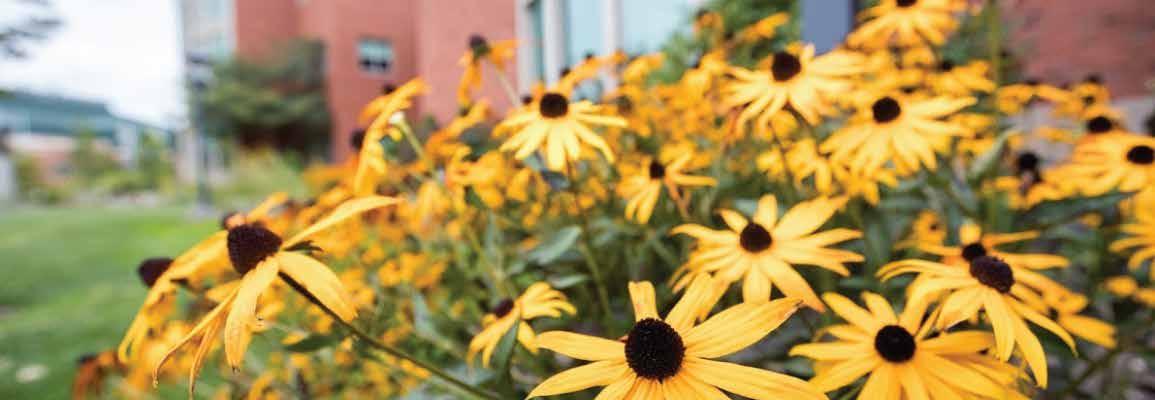


4
Thalia Coleman poses for a portrait in her Boone home Feb. 22, 2024. During her time at App State, Coleman recruited and mentored many students. Photo by Mayesivy Carlson
App State offers two five-week Summer Sessions with Face to Face, Online, and Hybrid Courses | news
Create a Productive Summer!


Binge Watch Try Prime Student for 6 months at $0 New members only. Terms apply. Grubhub+ and Saltburn included with Prime.





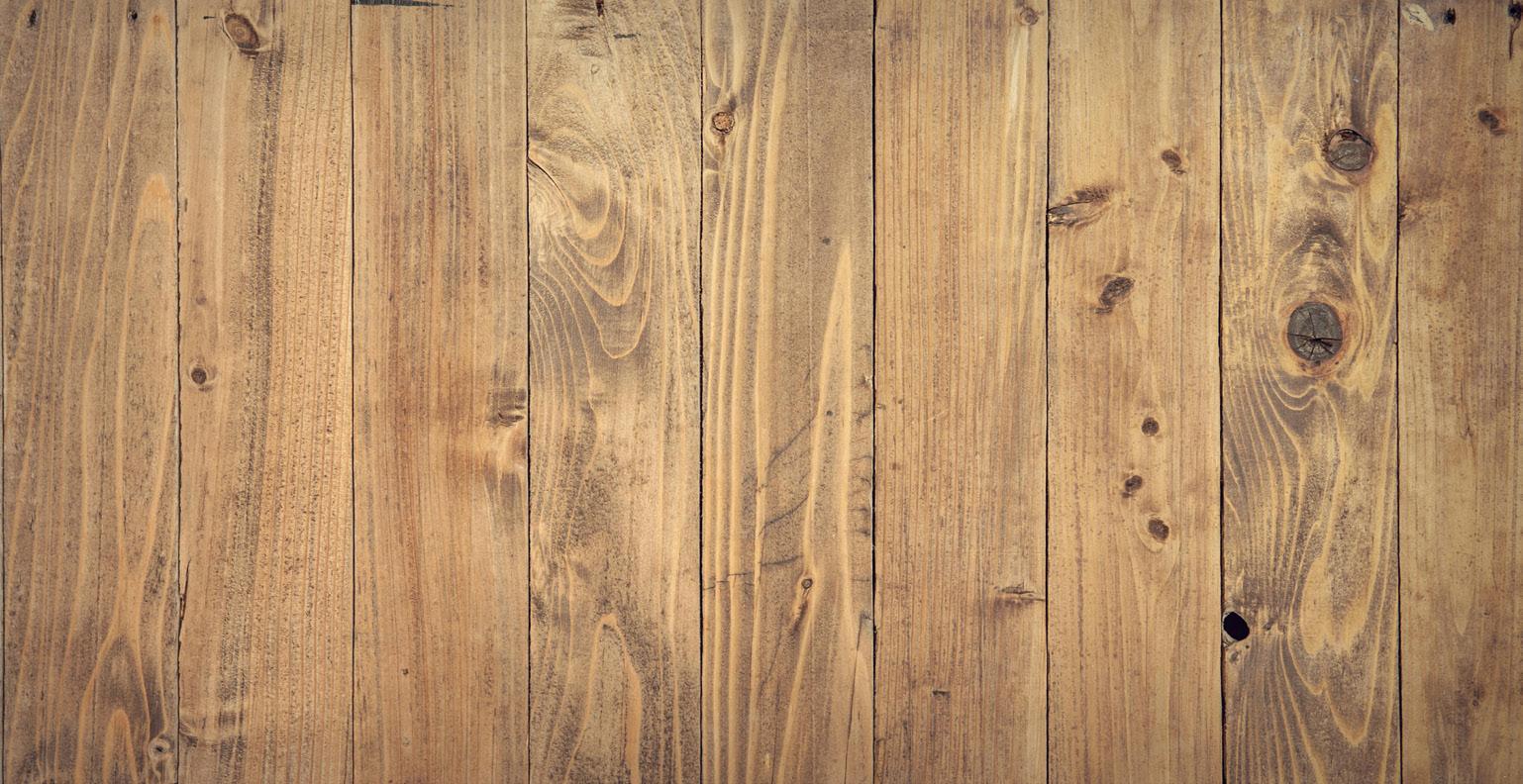
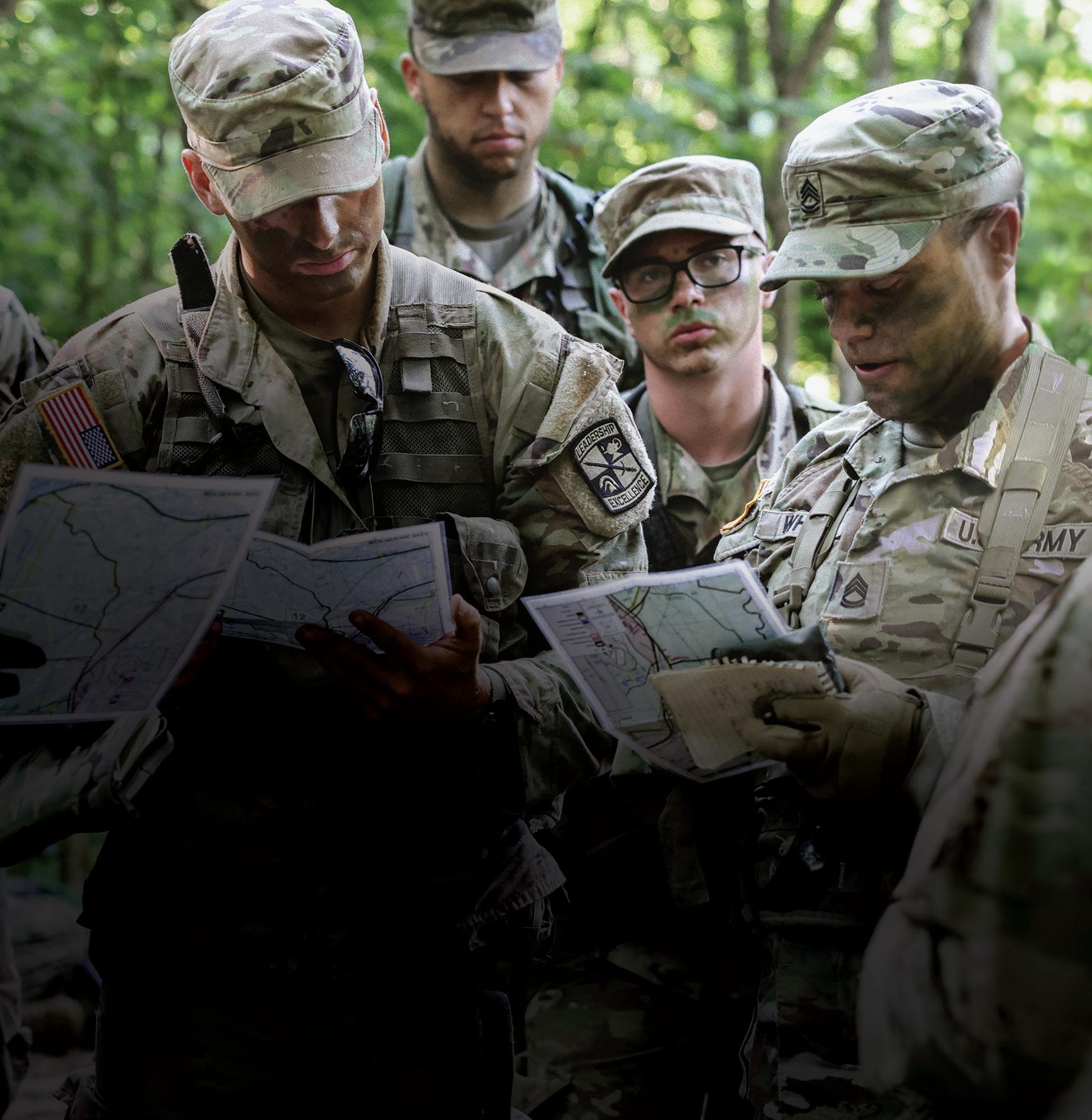
6 there?” 84 Drives too fast 86 Con text? 88 Half of quatorze ANSWER TO TODAY’S PUZZLE 3/10/24 3/10/24 ©2024 Tribune Content Agency, LLC. Cadet Summer Training puts you on an accelerated path to leadership as an Army Officer after graduation and can earn you scholarships and a monthly stipend. TAKE YOUR SUMMER INTERNSHIP OUT OF THE OFFICE. ©2024 U.S. ARMY. PAID FOR BY THE U.S. ARMY. Sophomores may qualify for a $5,000 bonus. Contact DJ Weatherford at (828) 262-2994 or weatherforddj@appstate.edu to learn more. ROTC.APPSTATE.EDU Watch the next game with us! (828) 355 - 9362 115 New Market center, boone, NC, 28607 available for delivery Scan to visit our website Boone, NC JOIN US! Meet the Trainer Day Mar�h �, ��am���m BOGO Training Sessions for �� days starting Mar�h � Salem Fowler Certified Personal Trainer | ads & games
Historical interpretative panels approved for Boone Cemetery
Sam Deibler | Senior Reporter
The Boone Town Council approved historic interpretative panels during their meeting Dec. 4 for installation throughout the Boone Cemetery.
Two textual panels and one sign, drafted by the Historic Preservation Commission, will be installed to inform visitors of the cemetery’s rules and notable history.
Located on Howard Street behind Summit Hall, the cemetery’s earliest burials date to the 1850s, before the town was incorporated. Integral figures of Boone’s history lie in the cemetery, including App State’s founders B.B. and D.D. Dougherty, and John Preston Arthur, author of the 1915 book “A History of Watauga County, North Carolina.”
Throughout its use, Boone Cemetery was segregated, with white burials reserved for the west section and Black burials reserved for the east section.
According to Watauga Democrat archives from 1918-48, locals referred to the white section as the “Boone” and “City” cemetery, while the Black section was called the “Colored” and “Negro” cemetery.
Burials in the white section were often accompanied by named markers, while most in the Black section went unmarked until 2022. At some points, a fence encompassed only the white section.
In 1957, incumbent Boone mayoral candidate Gordon Winkler and three city council candidates ran a campaign ad in the Watauga Democrat, promising constituents that, if reelected, the town would install a “modern fence around our city cemetery” and assume maintenance responsibilities.
After his reelection, the town constructed the chain-link fence around only the white section and began caring for the cemetery, which remained privately owned.
The fence stood until 2016 when the Town of Boone removed it after purchasing both sections of the cemetery.
In 1865, three Union soldiers died in Boone from disease and were buried side-by-side in the Black section, their graves among the few marked by named stones in the east side.
The panels’ text contains the general history of the cemetery and interprets its racial segregation and Union soldier burials.
“These are the themes that were selected by town council and that we were told to develop interpretation around,” Plaag said during a lecture on the Boone Cemetery Jan. 25.
The panels project began in February 2021, when the town manager at the time, John Ward, requested the HPC consider placing educational panels to help reduce incidents of skiing and sledding inside the cemetery.
In April 2021, the town council approved the HPC’s proposal to begin work on the panels. The project was delayed until September 2022, when members resumed discussion and research.
During their meeting on July 10, the HPC approved initial drafts of four interpretative panels, authored by Plaag, and sent them to be approved by the town council Aug. 9.
After substantial community feedback and suggestions, the project was delayed for months to consider the public requests for changes.
The original Panel #2, which listed rules for visitors, was changed to a sign. Panel #4, which interpreted the burials of Union soldiers in the Black section, was removed and a sentence mentioning the Union soldiers was added to the final draft of Panel #2.
The HPC originally planned to place QR codes on each panel that would link to a list of the prominent historical figures buried in the
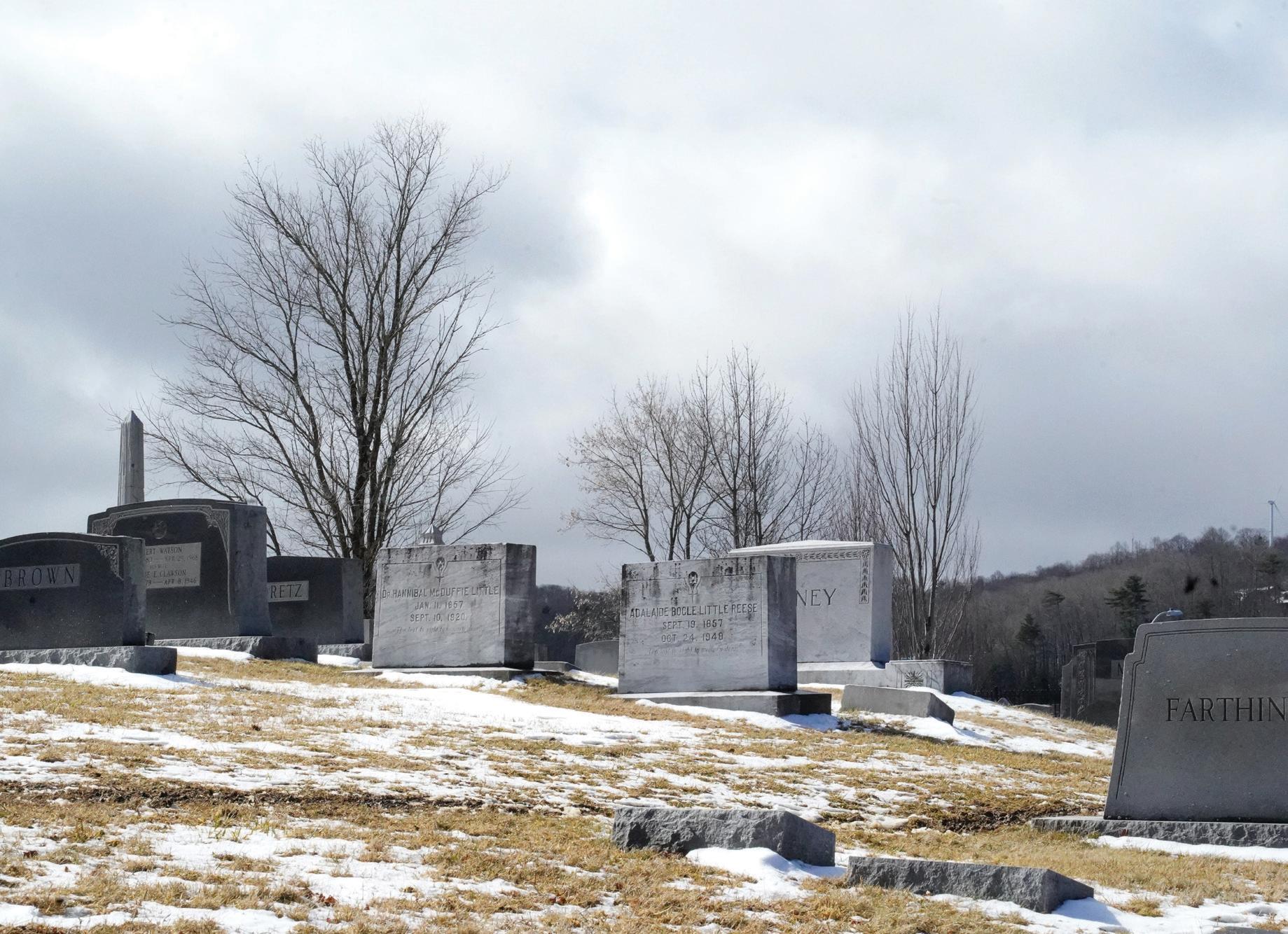
cemetery and more of the HPC’s research. Instead, pamphlets and brochures with similar content will accompany each panel.
On Nov. 14, the HPC approved final drafts for two panels and a rules sign.
Panel #1, titled “Boone Cemetery,” describes the basic history of the cemetery during its use and will be placed at the entrance of the cemetery.
Panel #2, “A Divided Cemetery,” interprets the cemetery’s racial segregation and will be placed at the dividing line between the white and Black sections where the chain-link fence used to stand.
The HPC is currently designing and ordering the panels, said Town of Boone Advanced Planning Specialist Jessica Mitchell.
Installation is expected to cost $3,500. Plaag, who left the commission in December to begin his tenure as a town council member, said he expects the panels to be installed during the summer.
The interpretative panels project adds to the efforts by the Town of Boone in the last decade to provide for the cemetery’s long-term preservation.
In 2015, the town purchased both sections of the cemetery after requests from community members to renovate and preserve the Black section, which was overgrown and poorly maintained.
In 2016, the town spent over $100,000 in preservation efforts, including clearing trees and brush that littered both sides of the cemetery, removal of the chain-link fence erected in the 1950s and using ground-penetrating radar to survey the Black section, which discovered 165 unmarked graves.
The Junaluska Heritage Association, in partnership with the Department of Anthropology, used courthouse records to discover some of the unknown burials. In 2017, the JHA unveiled a monument with the names of 78 known Black burials in the east section.
During the Spring 2021 semester, associate professors of anthropology Alice Wright and Cameron Gokee launched the Junaluska Community Archaeology Project, in which students researched and preserved the Junaluska community’s history.
In November 2022, project members and other volunteers in collaboration with the JHA installed flat stones above each unmarked grave throughout the Black section.
The leftover stones were repurposed in May 2023, when Wright, Gokee and the JHA led another group of volunteers and placed a line of stones between the Black and white sections, exactly where the chain-link fence used to separate them.
7
news |
The Boone Cemetery sits behind Plemmons Student Union. Photo by Taylor Ward
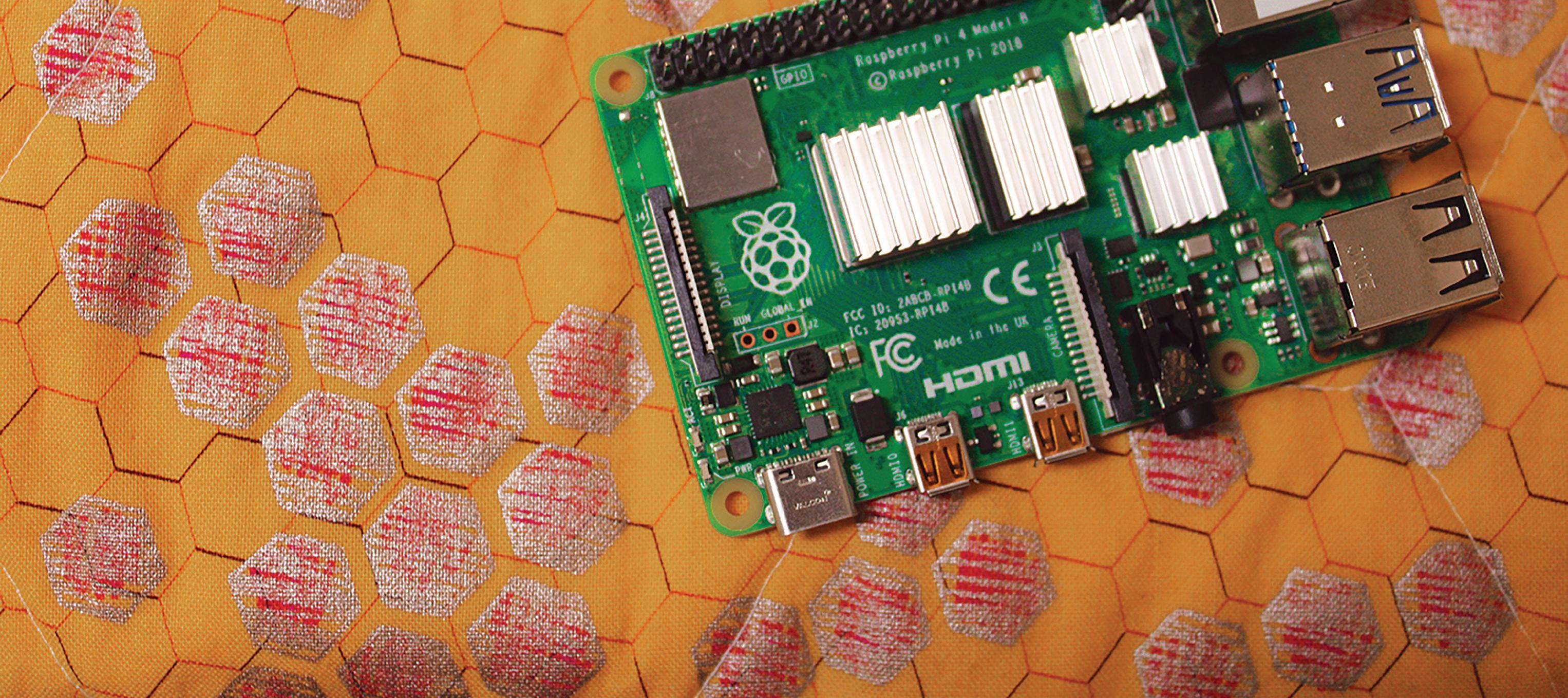
Computer science majors ‘buzzy’ with saving the bees
Katelin Potter | A&C Reporter
Honeybees play a vital role in the environment and the human food chain, but the species is facing a rapid population decline. However, a team of computer science majors at App State have been working to change that.
According to Bee Informed Partnership, a non-profit dedicated to researching and improving the health of honey bees, beekeepers throughout the U.S. lost about 48.2% of honey bee colonies within the last year.
The team of computer science majors are trying to save the bees by collecting data from the hives through technology and codes they have been able to create for App State’s Multipurpose Apiary Informatics Systems project.
“Bees are responsible for one third of our food. If they are not there we cannot produce enough food,” said Rahman Tashakkori, the director of AppMAIS.
UNC-Charlotte, created AppMAIS with the intention of saving the honey bees after learning the bees were dying at a rate of around 50% per year. The students and staff on AppMAIS have created a computerized bee hive that monitors the health of the bee colony year-round.
“We print and build all the equipment there,” Tashakkori said. “The students put it together and the idea is to learn from the audio, video, humidity, temperature, scale and genetics. We have been trying to save the bees.”
The program has 28 hives that they monitor daily. Six hives are on App State’s campus, six sit on the State Farm parking lot and 13 other hives are dispersed between Blowing Rock, Todd and West Jefferson. The team also has three hives located at Howest University of Applied Sciences in Belgium.
Raspberry Pi.
“It’s a computer that we put in, in front of the hive,” Tashakkori said. “They record the video from the entrance of the hive. Since then, we’ve had so much success by observing and listening.”
AppMAIS and the students that have participated in the program have worked for three years to provide a solution to colony collapse disorder.
“Colony collapse disorder is a huge issue for bees,” said Sophie Columbia, a senior and graduate research assistant for AppMAIS. “Bee colonies are just dying.”
With the impact bees have on our everyday lives, the team has to collect and understand a lot more data to understand why this has been a persisting issue, Columbia said. The more they learn the easier it will be to identify health issues in the hive and stage interventions to save the hive.
and check the hives manually. They limit the amount of times they open the hives because every time they open them, new problems may be introduced to the colony’s health and the bees will become stressed, Tashakkori said.
and hardware construction are the heart of the program. After all, it is a computer science program.

However, the bees tend to have other plans for the AppMAIS team as the queen bees can sometimes put themselves in danger. This can happen when a new queen hatches, leading the hive to split up for the protection of each queen. The portion of the hive that leaves may face many obstacles on their way, such as predators or severe weather. Another dangerous situation is when the queen happens to go outside the safety of the hive.
“A lot of people view computer science as this monolithic institution,” Simons-Rudolph said. “It’s really intimidating. It’s really difficult to get into. Only geniuses can code, and what I found is that it’s really not the case.”
The research students have found joy in the idea that their technical capabilities are able to be used in a tangible way that branches out beyond the lines of code.
Tashakkori and the other principal researchers, both at App State and at
AppMAIS has worked on monitoring all of these hives through a combination of codes they have written, equipment they 3D printed, cameras and microcontrollers called
Tashakkori and the AppMAIS team work to monitor the bees through as little hands-on interaction as possible. They only open the hives four times a year for Bee Monitoring, where they take genetic samples
“There’s been a couple of times that Dr. Tashakkori will call us up and say ‘A queen has gotten loose, somebody come down,’ and we have to go down and rescue the queen and put it back in the hive,” said Aedan Simons-Rudolph, senior and AppMAIS student researcher. “It’s fun, but I’m definitely better at writing software than I am at beekeeping.”
The coding, software creation
“It’s really nice to know that what I’m doing on the backend, even though I’m just writing Python, it does actually have an effect on the wellbeing of the hives,” Columbia said. Read more Online:

8
Raspberry Pi hardware sits on the honeycomb patterned cushion of Sophie Columbia’s desk. The AppMAIS team has the computer out as they work on their coding in Anne Belk Hall on Jan. 24. Photo by Katelin Potter
| arts & culture
Boone history: The weird dating rules of App State
Briley Turpin | A&C Editor
From humble beginnings as a small teachers college, App State has emerged as a harbinger of knowledge and learning in the mountains. However, in the beginning, the university had far more rules than the 2024 students are used to.
It seems commonplace now to head out of the dorm or apartment for a date whenever, without a curfew or rules. But, in the not so distant past, App State issued student handbooks that featured an outline of rules and regulations about dating, specifically for women.
Located on the fourth floor of the library is any history buff’s wonderland: The Special Collections Research Center. In this area of the library there are archives and books highlighting the history of App State, Boone and the greater Appalachian region.
Amongst the wealth of information in the special archives is a series of old handbooks from the 1900s that outline rules for student conduct, including rules around dating. So, let’s take a trip back in time to see what it may have been like to date at App State many decades ago.
The rules surrounding dating, as outlined in a 1948-49 handbook, start
were allowed one date per week, sophomores two, juniors three and seniors had no limit. It is interesting to note that there were no rules outlined for the number of dates men could go on per week.
Not only were there rules regulating the number of dates girls could go on, but there were also regulations about where these dates could take place.
The same handbook states, “All dating is carried on in the dormitory living rooms and the Assembly Hall.” It also clarifies no dates are permitted on evenings where there are other campus events “of general interest” scheduled. All dates were to begin at 8 p.m. and conclude by 10 p.m., and “conventional conduct” was expected.
The dates were monitored by the matrons of the dormitory, or, in other words, the dorm mom.
The handbook continued to include rules about movie privileges. Drive-in movies were popular in the 40s and 50s, and Boone had its very own drive-in theater at the time called Sky-Vu.
In order to obtain permission to see a movie, all girls were first required to maintain at least a “C” average grade in their coursework over the six weeks preceding the movie. If their grades were in shape, they then had to obtain permission from their parents to leave campus. The same limits to the number of dates applied to seeing movies; freshmen were allowed one movie per week, sophomores two, etc. Girls had to return to the dorms by 9:20 p.m. and were allowed these privileges only on weekdays.

Samantha Burnette, a graduate student studying history, looked into these dating rules when prompted to choose two topics related to the history of App State for a class assignment.
She said she stumbled upon them when she saw a timeline on the Special Collections website that discussed
student protests regarding social rules. She was unable to find much information about these protests, but instead uncovered the rules they were protesting.
“At the time, it was pretty common to have these really strict rules,” Burnette said. “You know, in an area like Boone that was very conservative, parents were hesitant to send their daughters off to school so at the time it was very common to have that paternal idea that women needed to be protected.”
While it seems hard to imagine these types of regulations in the current world, it wasn’t long ago that these rules were still in place.
“The last rules I could find was from 1960-61 in a women’s dormitory handbook,” Burnette said. “Up through the 60s, women were still limited to when they could even wear pants to classes or the library.”
When she realized how recently these rules were in place, Burnette said she was absolutely shocked. The more she researched, the more regulations she found.
In fact, women still
weren’t allowed to have cars on campus through the 60s.

“To see that this went on through the 60s, and then seeing that Bruce Springsteen performed on campus in 1976, just a few years after these rules
he’s still touring now is just crazy,” Burnette said.

 Graphics by Brianna Bryson
Graphics by Brianna Bryson



Step inside the Haus of Liqueur
Meg Frantz and Cameron Miller | A&C Reporters
who participate in most shows:
In chilly air and biting wind on a February evening, a small crowd huddled outside the doors of the Appalachian Theatre of the High Country, their breath foggy in the cold. At 6 p.m. sharp, a volunteer appeared to unlock the doors to the theater.
The crowd shuffled in, enveloped in the warm Art Deco glow and the smell of fresh popcorn in the theater’s lobby. Inside, local artists set up booths to sell their goods. Among the artworks were T-shirts, stickers and lighters plastered with the faces of the Liqueur family.
The Haus of Liqueur is one of the two main drag groups in Boone. They performed their show titled “The Bar is Open” Feb. 17 — something that was in the works for months.
The group was established two years ago when Bubbles Liqueur and Missy V Sour Liqueur, along with a friend who no longer performs, decided they wanted to form a group of drag artists looking to hone their craft.
Now the group has six members
Bubbles Liqueur, Missy V Sour, Lil Tito Liqueur, Brandi Maxxx, Rose Bush Liqueur and Jo Lean Liqueur.
As friends joined one another at their seats in anticipation of the Haus’ show, some discussed what they expected to see or reminisced on their last Haus of Liqueur experience. This show, however, was different. It was the Haus’ first gig at an establishment that didn’t serve food. They had put in their time at various local bar gigs and drag brunches, but this was the first time they would have all eyes completely on them.
“There was a lot of anxiety because we’re bar people,” said Haus co-founder Missy V Sour. “It’s easy when people are drunk or they’re hanging out with their friends. But this is a theater and the audience is different — they’re sitting.”
The Haus acts like a family both on and offstage, sticking with each other through thick and thin, particularly in moments where drag is under scrutiny.
In November 2022, a gunman opened fire at Club Q, an LGBTQ+
nightclub in Colorado Springs. Five people were killed and 25 others were injured in the shooting. Missy V Sour said every day after that, her mom called her to remind her “not to be a hero.”
“Our world got flipped,” said drag king Lil Tito Liqueur. “We started checking in with each other before shows, we made sure we knew where exits and first-aid kits were.”
Missy V Sour said since drag is political, continuing to take up the space and be loud and proud is important — even when the world is against drag.
“It’s hard because how do you comfort someone and say that everything is going to be OK when you don’t know that?” asked Missy V Sour.
Threats of physical violence are not the only issue facing the drag community. In the past few years, laws targeting drag have swept the U.S. The Gay and Lesbian Alliance Against Defamation reported there were 141 anti-drag attacks in the U.S. in 2022, with 10 attacks in North Carolina alone.
The Tennessee Adult Entertainment Act was signed on March 2, 2023 and bans “adult cabaret performance” in public and in front of children. This bill contains vague language about what “adult” means, but does make sure to specify “male or female impersonation,” effectively banning drag in Tennessee as well as putting transgender people at risk. As a result, the Haus of Liqueur has stopped taking gigs in Tennessee, limiting the number of opportunities to perform nearby.
With the current political climate surrounding drag, every chance to perform for a new audience is an important one. The Appalachian Theatre of the High Country is one of the biggest venues in Boone, so this show was a huge opportunity for the Haus to showcase their talents. Brandi Maxxx, a fan-turned-member of the Haus, referred to it as her “magnum opus.”
They had been working toward this moment for months. Every Tuesday from 8:30-10:30 p.m., the sounds of music, laughter and the pounding of high heels on hardwood echoed off
the mirrored walls of Northwestern Dance Studios in Boone. It was here the family gathered to run through their numbers, making sure every performance was just right down to the minute. Each performer brought their own special flair to their numbers, but the rest of the family was not shy about sharing their honest thoughts in hopes of making each other better.
Conceptualized as a variety show to highlight the diversity of its performers, preparations for “The Bar is Open” began in September 2023.
Serious planning started three months later when it was announced at the Haus of Liqueur’s holiday show at Lily’s Snack Bar.
“We liked the concept of ‘The Bar is Open’ because with the Haus of Liqueur, no two drinks are the same,” said Haus co-founder Bubbles Liqueur.
“You get something different, but delightfully tasty every time.”
The show began with co-hosts Bubbles Liqueur and Missy V Sour putting their natural chemistry on display with an opening dialogue full of witty banter and self-deprecating
10
| arts & culture
The full family of Haus of Liqueur gathers in front of their balloon display to snap a photo Feb. 17. Pictured from left to right; Missy V. Sour, Brandi Maxx Liqueur, Jo Lean Liqueur, Rose Bush Liqueur, Bubbles Liqueur and Lil Tito Liqueur. Photo by Hayden Wittenborn
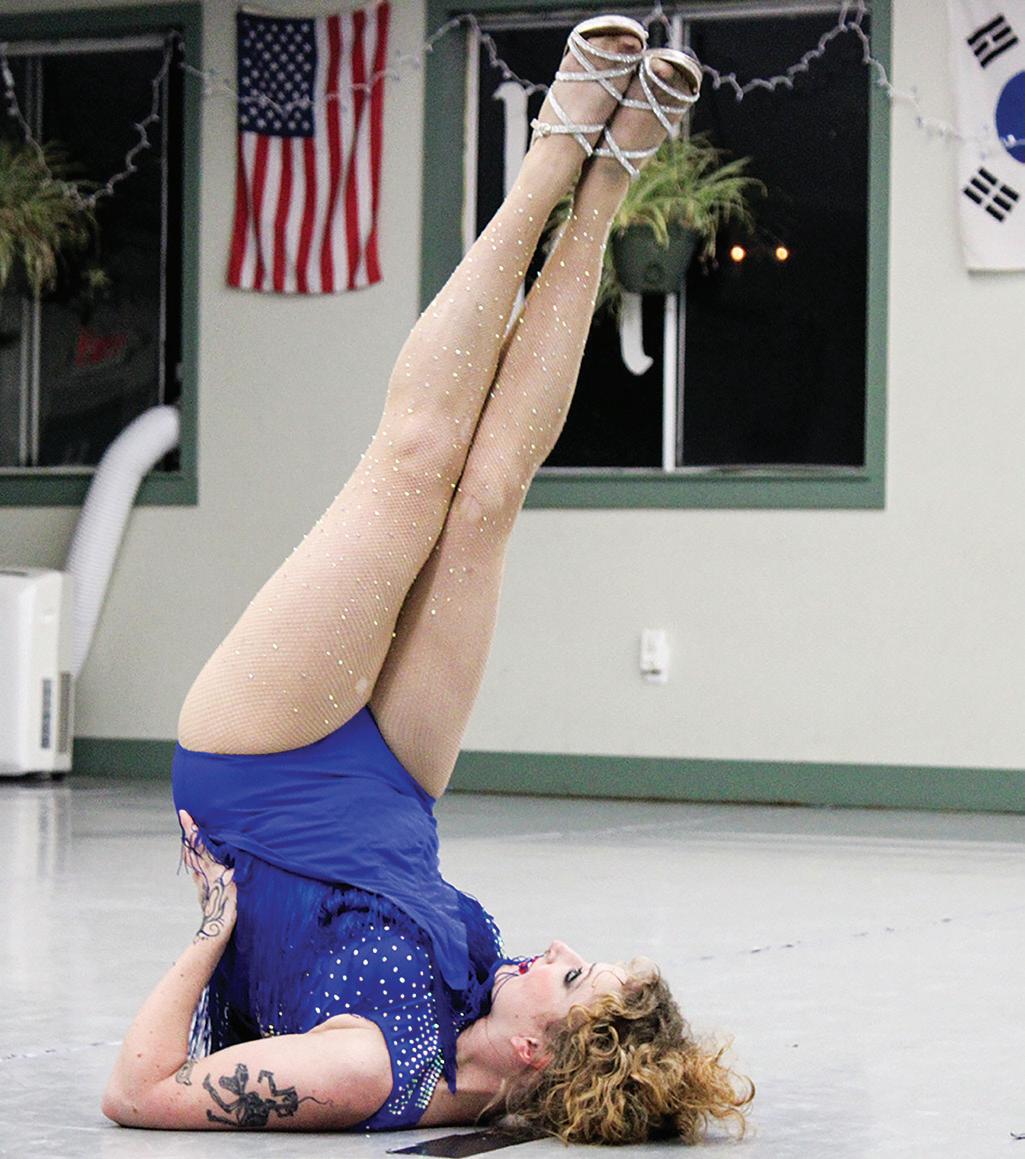
quips, leading into a duet performance of “Anything You Can Do” to kick off the show. What followed was a dazzling display of humor, emotion and infectious energy with brightly colored costumes popping against the black background of the stage.
Missy V Sour defined drag as any form of self-expression “through means that are cosmetic.” Bubbles Liqueur agreed, adding, “there’s typically a performative aspect to it.”
Bubbles Liqueur had already been doing drag for three years at the time of the Haus’ founding, but as a selfdescribed “COVID queen,” had never performed. Missy V Sour started performing drag once the Haus officially formed.
Bubbles Liqueur supports herself and the Haus as a graphic designer, having received her degree in graphic design from App State in May 2023. By day, she works for a design firm “pumping out business cards, pamphlets and brochures,” but she also puts these skills to use designing posters and other artwork for the Haus of Liqueur.

Read more
Online:





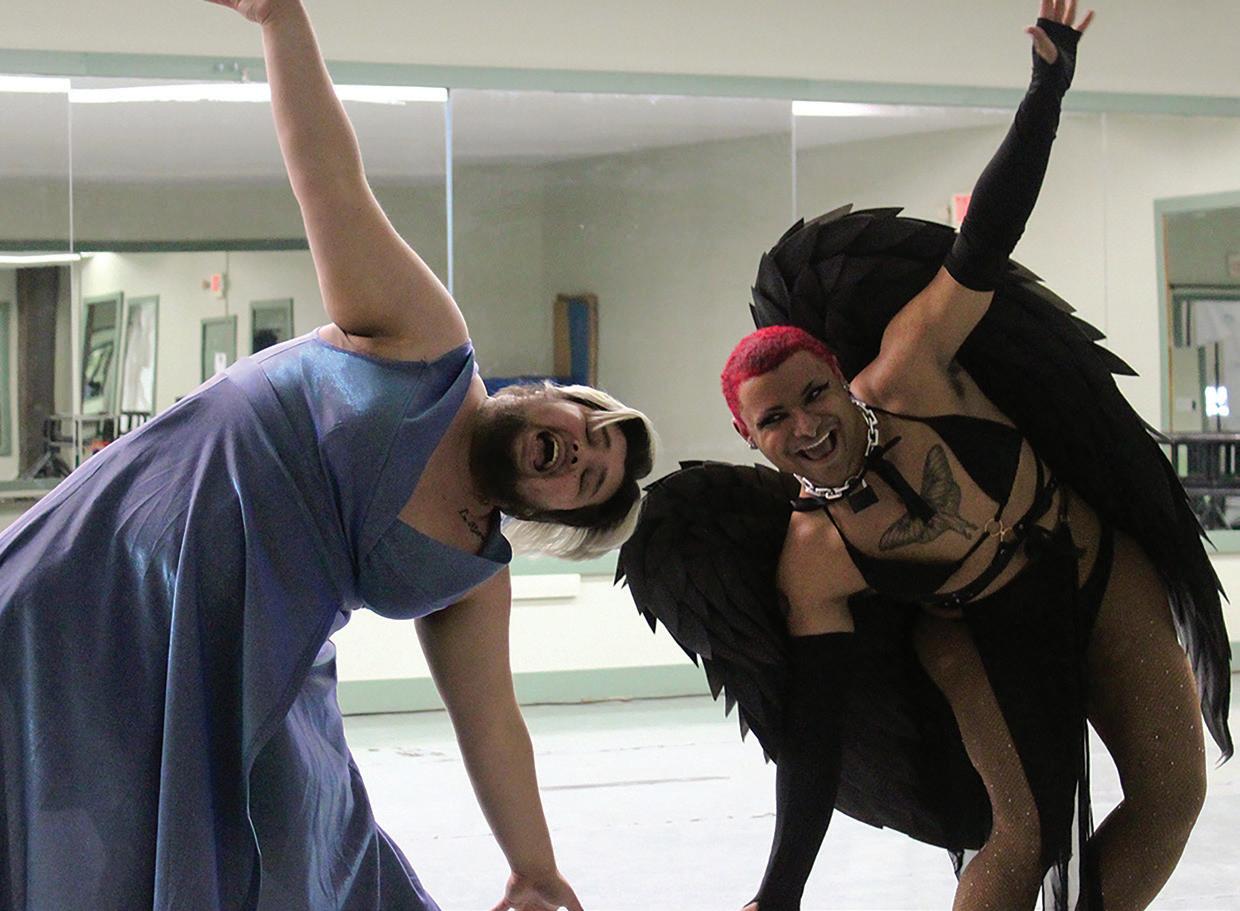




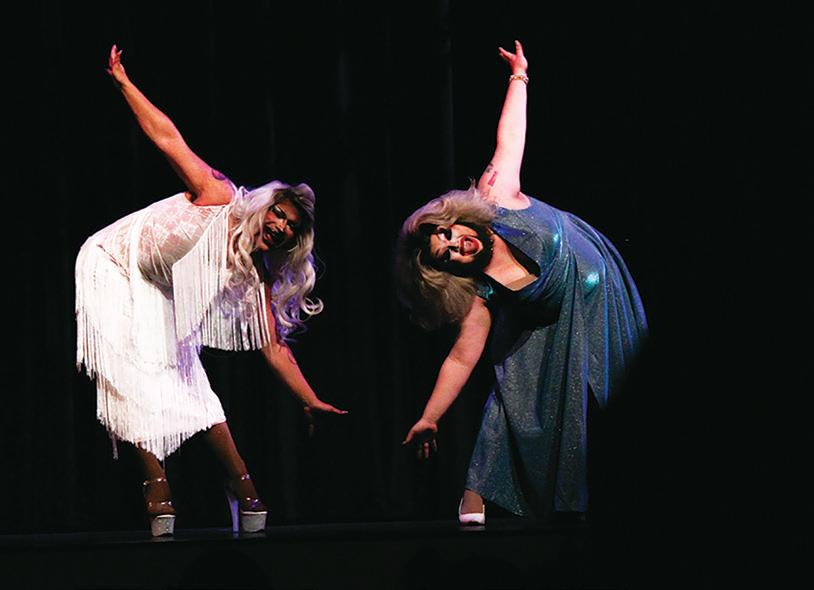



11
Brandi Maxx Liqueur practices in her costume during a dress rehearsal on Feb. 13 before showcasing her routine on stage Feb. 17 (pictured right). Photo by Hayden Wittenborn
Missy V. Sour and Bubbles Liqueur open the show with a performance of “Anything You Can Do” by Betty Hutton on Feb. 17. Photo by Hayden Wittenborn
The mother of Haus of Liqueur and co-host of the night Bubbles Liqueur performs her solo on Feb. 17 with a bold red lip and a cheetah-print dress. Photo by Hayden Wittenborn
Missy V. Sour silver dress was a crowd favorite of the night on Feb. 17. She was the co-host for the night alongside Bubbles Liqueur and ended the night with her dance to “CUFF IT” by Beyoncé. Photo by Hayden Wittenborn
The queen Jo Lean Liqueur wooed the crowd with her long red boa and Taco Bell references on Feb. 17. Photo by Hayden Wittenborn
A drive through AppalCART’s history
Thomas Turner | News Reporter
As App State celebrates its 125th anniversary in 2024 and students reflect on the history present on campus, it would be remiss not to acknowledge AppalCart, which has been providing public transportation for students and members of the Boone community for decades.
Beginning as the Watauga County Transportation Authority in January 1980 and rebranding as AppalCart in October 1981, AppalCart and its drivers have adapted to the needs of App State and Boone to provide public transportation for over 40 years.
“AppalCart is no longer considered a small rural system by many across the state of NC and across the country,” wrote current AppalCart director Craig Hughes in an email.
“AppalCart continues to work with the university to identify efficient ways to move students around campus and the Town of Boone.”
The first real-time bus tracking app, NextBus, was developed in 2015. Prior to this innovation, students and drivers had to rely on other methods of tracking buses to get from place to place in a timely fashion.
“They would just call AppalCart dispatch and ask them where the bus was at,” said Pop 105 Route driver Louis Ogletree, who has worked for AppalCart for 22 years. “They wouldn’t know where the bus was if they didn’t have a printed schedule.”
The printed schedules, which sit

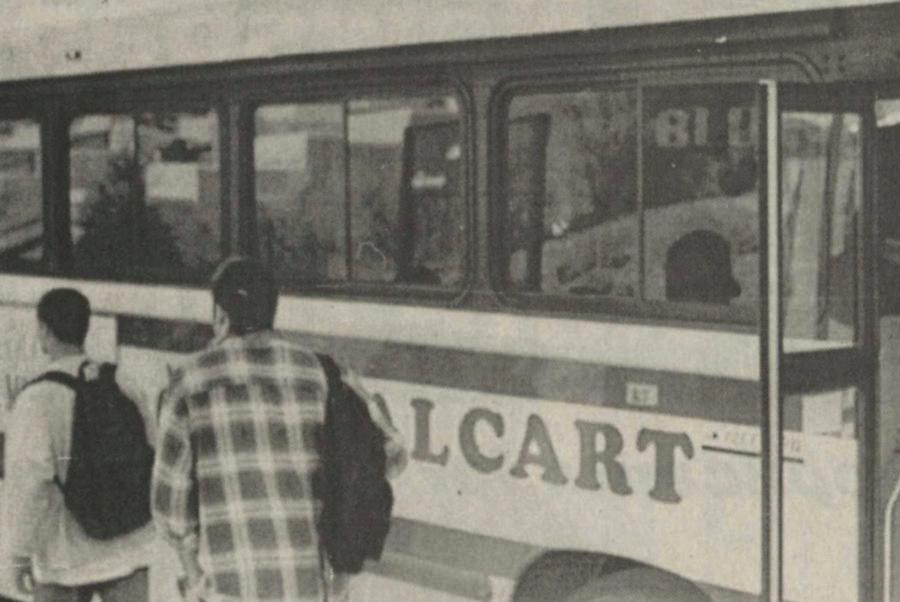
as they were in having more seats.”
The trolley that served as one of the first AppalCart buses was eventually sold to Edenton, where it is now used for historical tours, Turner said.
its transportation going forward.
toward the front of every AppalCart bus, were once the primary method for App State students and Boone community members to track where a bus was at any given time. While anyone with a smartphone has the option of downloading the ETA SPOT app to see where the buses are in real-time, the printed schedules are still available for those who may not be used to the app’s interface or the AppalCart bus route operations.
Today AppalCart operates on a consistent schedule, but it was not always this way. Within five years of its founding, AppalCart changed directors three times until former director Christopher Turner, who
served in the role from September 1985 to June 2015.
When Turner became director, AppalCart was in the process of scaling back its reach, reducing from four routes to two. The organization did not have any actual buses at the time either, Turner said.
“The first bus that we got wasn’t even really a bus, it was more of a trolley, cause we thought it would increase ridership if we had something unique looking,” Turner said. “Once we got transit buses, students weren’t as interested in the trolley anymore
By the end of his tenure, the number of routes increased to 12, with high-capacity Gillig buses becoming the new standard for AppalCart transportation. AppalCart prides itself on its history of adapting to the needs of Boone according to its website. As early as 1982, AppalCart began using lift-equipped vans to assist disabled passengers. In 1986, they introduced the Express Route to alleviate overcrowding on the Red Route.
The year 2018 saw a major reconfiguration of the AppalCart routes, resulting in the current total of 14 routes during regular university operations, eight routes during university breaks and three Night Owl routes for those who need transportation at later times than are typically available.
Despite how much AppalCart has evolved over the past four decades, they are still committed to improving
According to Hughes, AppalCart has received funding from the NC Volkswagen Settlement Grant to purchase their first electric bus and charging station, an initiative that is still in the process of expanding. AppalCart also plans to introduce its first double-decker bus sometime in 2025 to relieve current overcrowding on its buses.
Over the course of its 43-year history, AppalCart has served App State, the town of Boone and Watauga County as a whole with consistent transportation, a practice they hope to continue long into the future.
“We keep trying new things to help the town, the county and the university,” Turner said. “I enjoyed my time serving as AppalCart director, and I’m glad to see that it’s still growing and meeting the needs of all the folks who are in need of transportation service in the Boone area.”
As students step onto one of the many AppalCart buses to take them wherever their heart desires, work goes into making that journey possible on both a small and large scale. From the drivers to directors, many AppalCart employees have served the App State community for so long, forming the backbone of transportation in Boone.


Wellness and Prevention Services for FREE safer sex supplies, Narcan, and fentanyl testing strips!
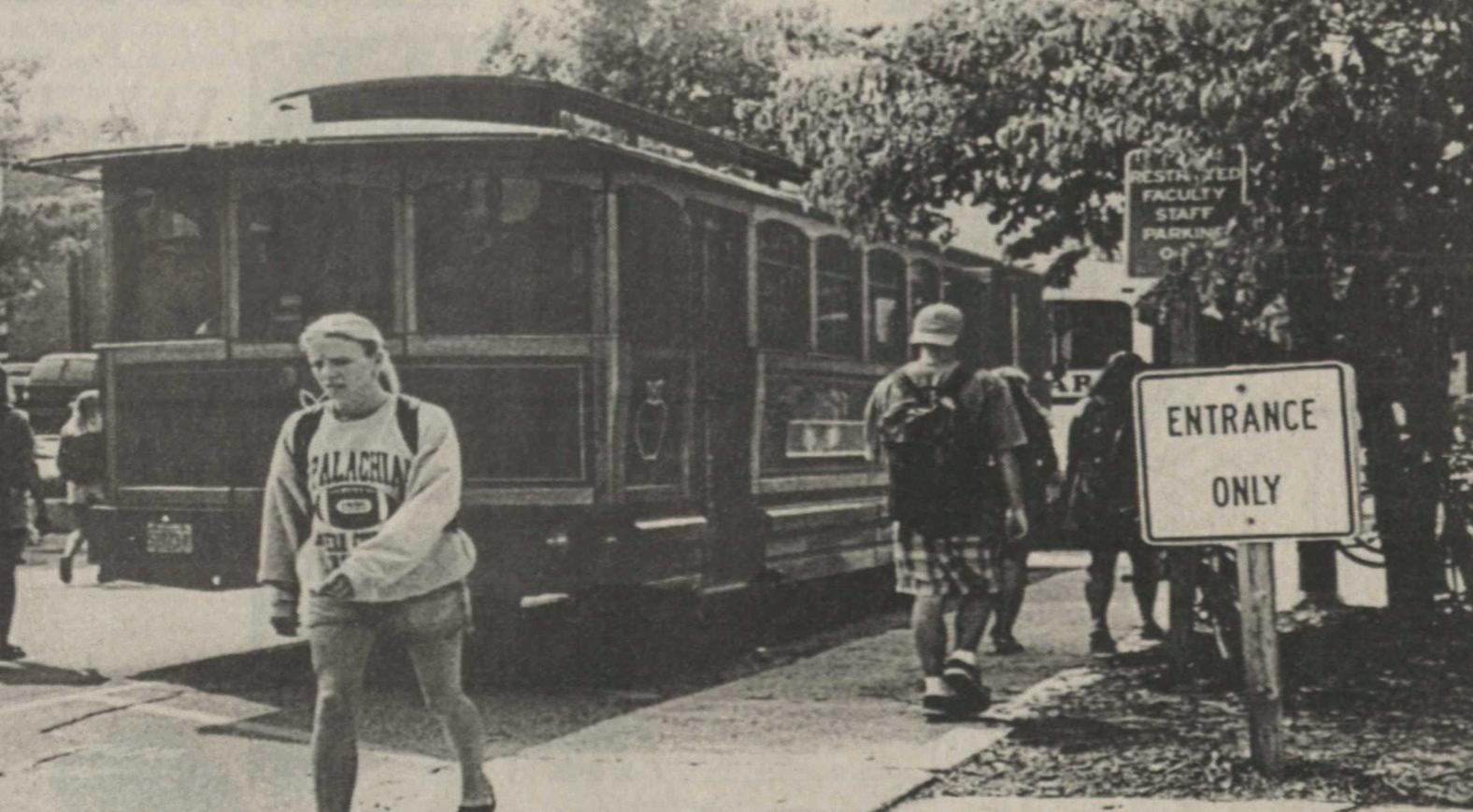
12
OUNTAINE E R
Y wants you to party smart! ! Come to
M
RECOVER
AppalCART offers convenient service for students. Photo and caption originally published in The Appalachian, March 3, 1996.
AppalCART used to have a trolley as one of their vehicles.
Photo originally published in the Sept. 10, 1996 issue of The Appalachian by Natalie Collins
Some of the biggest names from the last 90 years of App State Athletics
Ethan Smith | Sports Editor & Chance Chamberlain | Associate Sports Editor
App State Athletics garners attention and support from students, locals and alumni on a daily basis. This support comes from the help of past student athletes and coaches building each program into what it is currently as they continue to grow under present-day athletes and coaches.
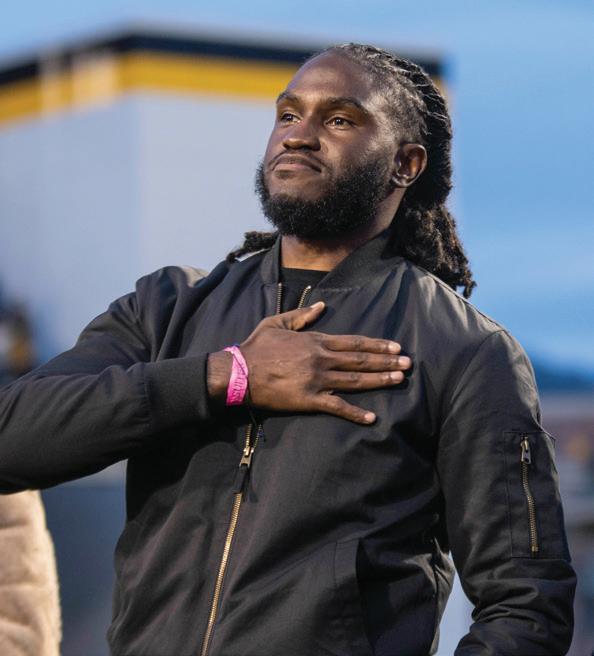
Armanti Edwards
The history of App State football cannot be told without quarterback Armanti Edwards. The four-time All-American dual-threat quarterback led the Mountaineers from 2006-09, winning back-to-back FCS national championships in 2006 and 2007. Edwards became the first two-time FCS National Player of the Year in 2009.
During his four years in the Black and Gold, Edwards amassed 10,392 passing yards, 4,361 rushing yards and 139 total touchdowns. Edwards set 64 school and 14 SoCon records.
“We all know the kind of impact he had,” said former Mountaineers quarterback Jamal Londry-Jackson.
“The G.O.A.T.”
He still holds the FCS record for career rushing touchdowns by a quarterback and the most seasons with more than 3,000 yards of total offense, in addition to holding App State’s single-game passing yards record at 433.
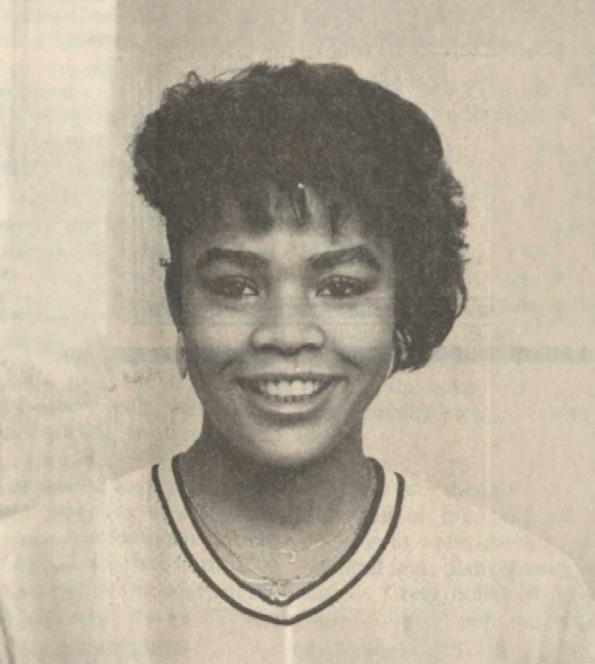
Valorie Whiteside
Recruited by former Mountaineers women’s basketball head coach Linda Robinson, Valorie Whiteside immediately became a star player for the Black and Gold, averaging 27.1 points and 15.5 rebounds per game her freshman year. Those stat lines earned her first-team All-American, the first ever for either App State’s men’s or women’s basketball.
In her sophomore year, Whiteside scored a program-high 48 points against Western Carolina on Jan. 23, 1986, which still stands today.
In Whiteside’s next two years, she guided the Black and Gold to two consecutive SoCon Championships in 1987 and 1988.
Throughout her App State career, she earned All-SoCon selection four times and was a three-time AllAmerican. Whiteside totaled 2,944 points, ranking 17th on the NCAA’s all-time scoring list. She was inducted into the App State Athletics Hall of Fame in 2003 and the SoCon Hall of Fame in 2009.
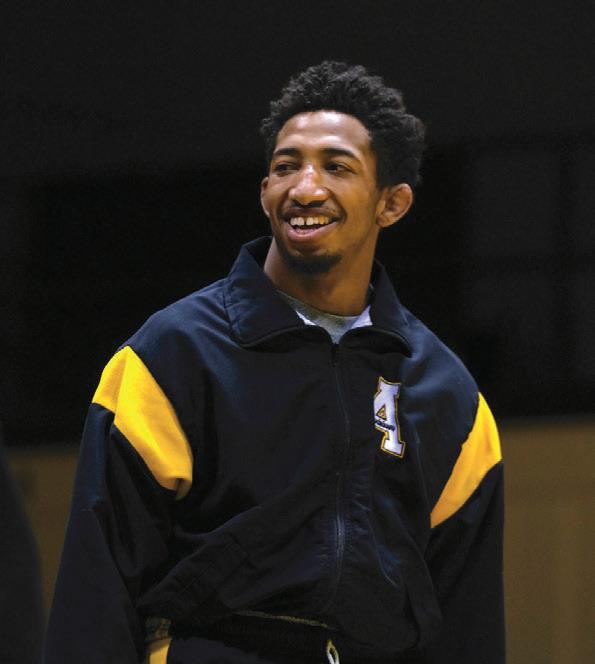
Jon Jon Millner
The four-time SoCon champion and NCAA qualifier Jon Jon Millner finished with a career record of 121-24 during his App State career, and ranks third in school history in victories.
Millner improved to 31-4 in his redshirt sophomore year as he started the season 12-0, and ended the season with another 12-match win streak. He earned the title of SoCon champion and was seeded No. 18 for the NCAA Championships, which was canceled by the COVID-19 pandemic.
The following season, Millner earned the nod of All-American and placed eighth at the NCAA Championships while being named SoCon champion. He went into the NCAA Championships with a 13-1 record, including an 8-0 record in SoCon duals.
After a successful redshirt junior year, Millner responded with a 24-4 season and was named SoCon Wrestler of the Year in 2021-22. This included a sixth-place finish at the NCAA Championships as he became a two-time All-American.
In Millner’s final year, he was named SoCon Wrestler of the Year as he finished with a 29-3 overall record.

Donald Sims
One of the most accomplished players in App State men’s basketball history is former guard Donald Sims. The 6’1” guard from Gaffney, South Carolina ended his career as the program’s all-time leading scorer with 2,185 points in 130 games.
Sims played from 2007-11, averaging 16.8 points per game along with 2.7 assists and 2.7 rebounds for his career. He scored a career-high 44 points for a Black and Gold win over Davidson 78-68 Jan. 9, 2010.
Sims earned first team All-SoCon as a junior and senior, while becoming the fourth Mountaineer player to score over 500 points in back-toback seasons. He became the third player in program history to record two 40-point games after scoring 40 against Mississippi State Nov. 19, 2010.
By the end of his career, Sims held five other program records in addition to being App State’s all-time leading scorer. He set program records in three-pointers, free throw percentage, free throws, three-point attempts and field goal attempts.
Currently, Sims plays professionally for Club Atlético Aguada in Uruguay.

Jerry Moore
The man, the myth, the legend himself. Moore is arguably one of the most significant people in App State history.
“I think when you say Appalachian State football, what’s the first person you think about,” said head football coach Shawn Clark. “The first word comes to your mind is Jerry Moore.”
Moore coached the Mountaineers from 1989-2012, compiling a 242135-2 record while winning Southern Conference Head Coach of the Year eight times.
In 2014, Moore was inducted into the SoCon Hall of Fame and College Football Hall of Fame, while he entered the App State Athletics Hall of Fame in 2015.
“He’s a very important part of this program because he made a lot of things happen,” said former App State linebacker Trey Cobb. “I feel like that’s someone who will never be forgotten, and when he comes around, everyone tries to speak to him and at least introduce ourselves to him because we know how important he is to this program.”
In 2021, Moore was honored with a statue outside Kidd Brewer Stadium in the north end zone plaza.
13
Read more Online:
(From left to right) Armanti Edwards photographed by Landon Williams Valorie Whiteside photographed in 1988 by The Appalachian. Jon Jon Millner photographed by Ashton Woodruff. Donald Sims photo courtesy of App State Athletics. Jerry Moore photographed by Max Correa
Kermit Smith encourages players to step up to the plate
Tess McNally | Sports Reporter
Kermit Smith holds the title of being one of the best App State baseball coaches of all time.
Smith gets his experience as an encouraging coach from being a ball player himself in 2000 for Pfeiffer University. He played one season, then met former App State baseball coach and current Duke coach, Chris Pollard.
In 2000, Smith was an assistant coach for Belmont-Abbey for a year. After seeing his potential and expertise as an assistant, he went on to be head coach of the American Legion post. Eighty-two former league post players have been inducted into the Baseball Hall of Fame.
From 2002-07, Smith served as a chair for Conference Carolina coaches while holding the position of chair for Belmont-Abbey College.
In 2007, Smith worked toward a master’s degree and earned it in sports management from California University of Pennsylvania.
Smith led the Crusaders to two Conference Carolina titles and a World Series in 2009 as BelmontAbbey’s head coach from 2001-09.
Lander University took in Smith as head coach in 2009. He gave the Bearcats the tools they needed to acquire the PBC Championship, two NCAA Regional II titles and two College World Series appearances.
In 2016, Smith joined the Mountaineer family. In 2023, the Black and Gold celebrated 30 wins, their most since 2013. App State concluded their 2023 campaign with 16 conference wins, six series wins and three tournament wins.
“To produce and get wins as a team, everyone has to contribute,” said Grey LaSpaluto.
LaSpaluto is a graduate student for the Mountaineers, working on obtaining his master’s in accounting. He is a right-handed pitcher and an occasional infielder for the game. In
2023, he produced a career-best 6.39 ERA.
“He would always make small talk with you and get to know your family,” LaSpaluto said. “Just on a personal level.”
In Smith’s sixth season with the Mountaineers, he chose to be an assistant coach with Team USA Baseball’s Prospect Development in Cary. It’s a program designed to let players 18 years old and under serve in an identification event for the 18U National Team.
This season, Smith welcomed six true freshmen in addition to accepting players from the transfer portal. The portal opens up in the summer, leaving the coaching staff with three months to decide who looks promising and if they want to recruit them to App State.
Smith talked about the qualities he looks for in players to make them a Mountaineer.
“It’s going to start with talent,” Smith said. “First, you need to assess your own roster, what is the ability or talent of the person that’s at the portal that could potentially fit what you need.”
Getting to know a player on a personal level before accepting from the transfer portal and for recruitment from high school is the most important thing, Smith said.
“We listen to that locker room a lot,” Smith said. “We ask ourselves is this a guy that would walk into what we do and fit in.”
Redshirt junior pitcher Bradley Wilson is a general management major in hopes of becoming a financial advisor after college. Wilson is a right-handed pitcher for the Black and Gold. This season, he has an outstanding ERA of 2.25. Wilson expressed how welcoming the team was for him.
“He’s always fun,” Wilson said. “When you need to be serious,
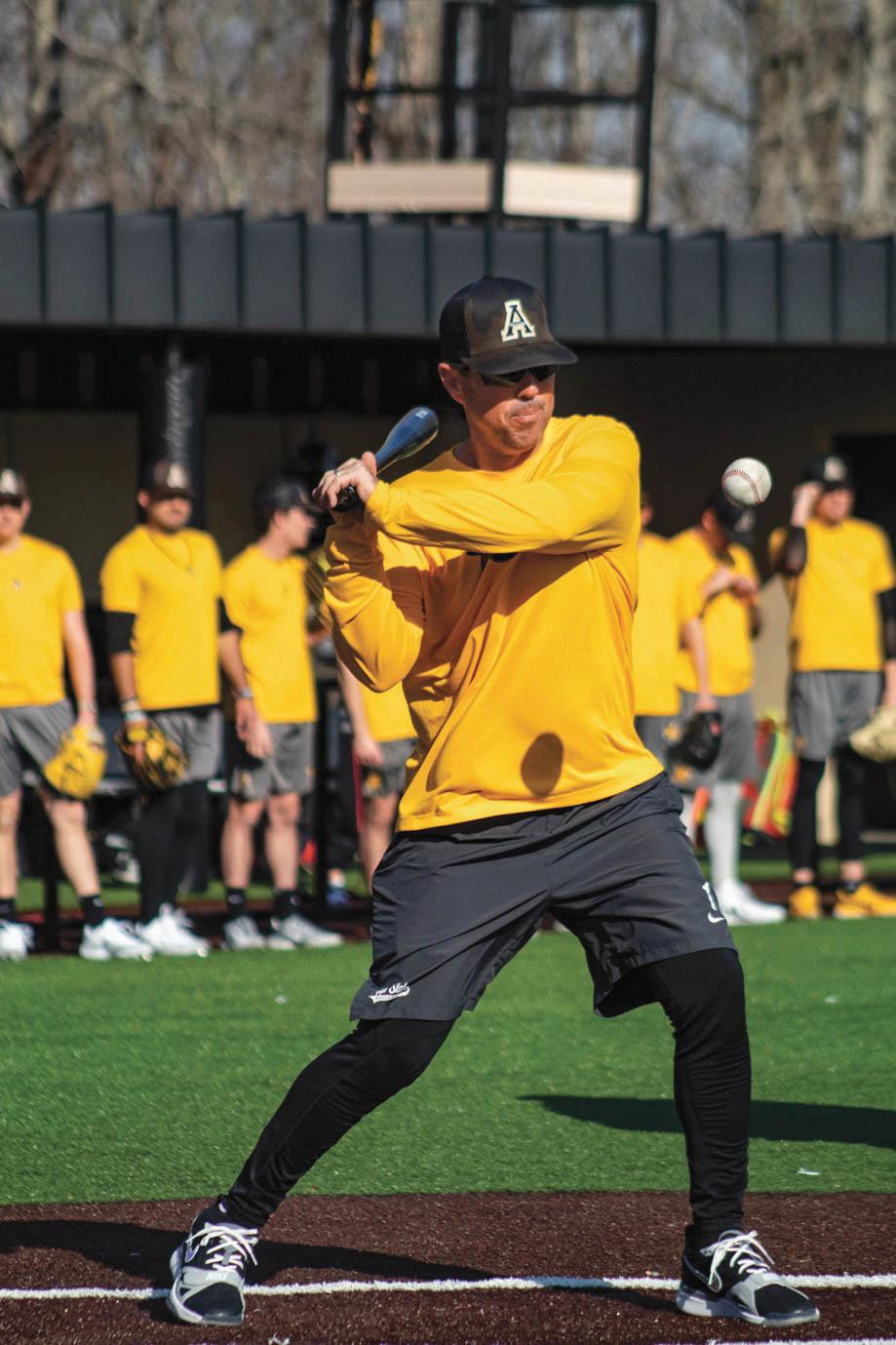


obviously be serious, but he likes to have fun.”
The baseball program has seen changes throughout the years since Smith arrived.
Pitchers now have accessibility to the Pitching Lab, a program that includes numerous cameras that dive deep into the biomechanics of a pitcher’s throwing arm to find the root of a problem or to adjust pitches.
“It helped me a lot with pitching development,” LaSpaluto said.
Structural foundations and personal relationships with players is very important to Smith.
“We spend a lot of time together, other than just playing on the field,”
Smith said. “When we interact on the bus, hotel or restaurant, or you know just at practice, I hope they look forward to just as much as I do.”
As the 2024 season kicks off, the culture and the mentality Smith exudes continues to flourish and grow stronger.
“It’s bigger than just winning or losing a baseball game,” Smith said. “It’s built with the foundation of toughness and honestly just hard work.”
Many memorable games have gone down in the history of App State baseball such as Coastal Carolina, Southern Miss and Florida Atlantic University.
“Beating Troy in the tournament last year was my favorite,” said Wilson and LaSpaluto.
Smith had a hard time choosing a favorite game in his many seasons here.
“There’s been a lot over the years, that has been a great deal,” Smith said.
“We’ve had some program firsts here, we had the first tournament win in Sun Belt history, which is always significant when you have a first.”
14
Head coach Kermit Smith during spring training on Feb. 22. The 2024 season will be Smith’s 8th season at App State, he was also named the 13th coach in program history. Photo by Max Sanborn
Head coach Kermit Smith conducting pitching and batting drills with the team on Feb. 22. Smith won the 2016 American Baseball Coaches Association/Diamond Southeast Regional Coach of the Year. Photo by Max Sanborn
| sports
Head coach Kermit Smith helping the outfielders get used to different batting styles on Feb. 22. One of the many awards Smith has received is the South Atlantic Region Coach of The Year, which he received in 2009. Photo by Max Sanborn
Designer name, designer game: St. Laurent stars in outfield

Chance Chamberlain | Associate Sports Editor
With spring approaching in the High Country, the Mountaineers will trot onto the diamond with a team highlighted by redshirt junior outfielder Austin St. Laurent.
Head coach Kermit Smith described him as a “really special kid” and a “really special player.”
“I love coaching him,” Smith said.
From Elon, St. Laurent graduated from Western Alamance High School in 2020, ranked as the 17th overall recruit in North Carolina by Perfect Game.
As a sophomore, he posted a .400 batting average with 24 RBIs and a .360 average as a junior. St. Laurent was a team captain in his senior year before enrolling at East Carolina.
“We step on the field, and these guys are looking at me to set the standard and bring the energy,” St. Laurent said of his team captain status.
In Greenville, he redshirted his freshman year and played collegiate summer ball for the Carolina Disco Turkeys, but entered the transfer portal in June 2021. On his way to post a .321 batting average in summer ball, the Disco Turkeys traveled to play the Boone Bigfoots in Jim and Bettie Smith Stadium. His visit to Boone in 2021 was his first time returning to the High Country since playing baseball at 14.
This wasn’t his last time returning as St. Laurent transferred to App State heading into the 2022 season. Smith and his staff recruited him throughout the summer and made a connection with their future starter.
“God found a way to get me on the mountain,” St. Laurent said.
By joining the Mountaineers, St. Laurent built a connection with Smith and considers him a father away from home, as Smith’s team culture
revolves around life and family, not just baseball.
“He’s definitely somebody that I can rely on, and somebody that I see being in my life for years,” St. Laurent said.
In his first season in the Black and Gold, St. Laurent became the fifth Mountaineer in program history to be named Sun Belt Freshman of the Year. He led the team in on-base plus slugging, slugging, hits, triples and total bases, catapulting him to earn Sun Belt honors and be named Freshman All-American by Collegiate Baseball.
At the plate, St. Laurent tallied 60 hits, 32 runs, 25 RBIs and four home runs in 2022. Defensively, the Mountaineer shortstop switched to first base for the majority of the season before switching back to shortstop due to a teammate’s injury.
“I came in and I told coach that I just wanted an opportunity to play,”
St. Laurent said. “It doesn’t matter where.”
As a team, the 2022 Mountaineers lost in the Sun Belt Tournament quarterfinals to Georgia Southern after a 20-33 season record.
With a retooled, senior-led 2023 team, App State had high hopes entering the season after being doubted and picked to finish 12th in the Sun Belt preseason poll.
“We have an opportunity to take this team to a higher level and compete for another championship,” said former Mountaineer infielder Luke Drumheller at the 2023 media day.
St. Laurent batted a .286 average with 44 hits, 36 runs, 18 RBIs and two home runs. Additionally, he started at shortstop and outfield throughout the season as the Black and Gold began 7-0.
Unfortunately, St. Laurent’s season was derailed by an injury, and forced
him to miss 15 games in April and May.
“The main thing that I was looking to do is see how I could help our team in a different way,” St. Laurent said. “Whether that was bring a lot of energy, or see if I can just make somebody’s day better.”
After being cleared to play, St. Laurent joined a Mountaineer team that upset No. 8 Coastal Carolina 11-0.
The Black and Gold finished the season 30-25, including a programrecord 16 Sun Belt victories and a Sun Belt Tournament run concluding in the semi-finals against Southern Miss. Going into his redshirt junior season, St. Laurent fully recovered from his injury and improved upon his game too.
15
Read more Online:
sports |
Redshirt junior outfielder Austin St. Laurent, pictured here on Feb. 21, garnered the 2022 Sunbelt Freshman of the Year Award. St. Laurent became the fifth App State freshman to win this award, as he led the team in OPS, hits, total bases and tied for the batting average lead. Photo by Ashton Woodruff
“Give everything you have”
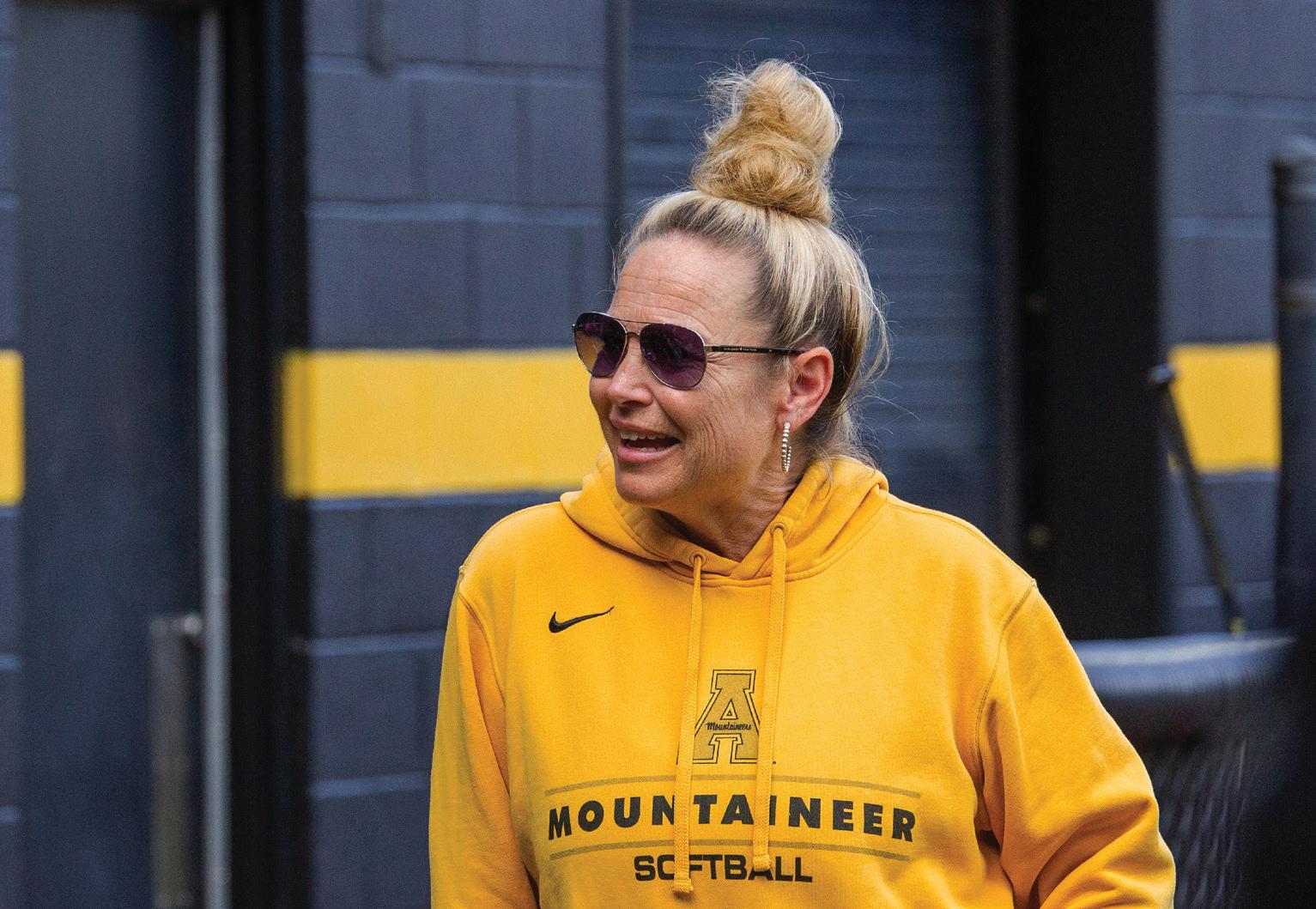
Softball coach’s journey in the High Country
Ethan Smith | Sports Editor
“I love my players, I love this team,” said softball head coach Shelly Hoerner. “It’s pretty cool to be able to come to the field and just interact with them on a daily basis.”
Now in her seventh season, Hoerner continues to lead the Mountaineers onto the Sywassink/ Lloyd Family Stadium field.
Hoerner started her softball journey at 5 years old, when she joined her first organized team. Despite being too young for the league and the equipment being too large, Hoerner’s coaches allowed her to play, seeing the passion and enthusiasm for the game.
In the collegiate ranks, Hoerner played two seasons at Barry University, a Division II program in Miami Shores, Florida. Playing catcher for the Buccaneers, she helped lead them to the Division II College Softball World Series while being an allconference selection. She struck out six times in 224 at bats, while scoring 41 runs and posting 30 RBIs.
Hoerner then transferred to Canisius College in Buffalo, New York, where she helped lead the Golden Griffins to back-to-back MAAC titles
in 1995 and 1996. In both seasons, she was an all-conference selection. Following her college career, Hoerner played catcher professionally for Cavigal Nice Sports in Nice, France in 1998.
Hoerner got her first head coaching opportunity at Valdosta State in 2000 for one season, where the Blazers went 14-38. While her first season did not go as planned, it served as a learning opportunity for the new coach.
“It was just very humbling,” Hoerner said. “I knew my hard work would pay off, and 25 years later I feel it has. I think you learn a lot from losing and you learn your patience, you learn how to handle different situations.”
After Barry, Hoerner moved onto the College of Charleston, going 254-206 and winning Southern Conference Coach of the Year honors in 2007. Hoerner moved on to Georgia Tech after a five-year stint with the Cougars, where she earned her 500th career win in 2016.
In June 2017, Hoerner was announced as the next head softball coach for the Black and Gold. During a meeting with App State Director of
Athletics Doug Gillin, she was sold on the atmosphere in the High Country.
“When we met, I just had a really good vibe,” Hoerner said. “When they brought me to campus, it felt very family oriented and that has not changed in the seven years that I’ve been here.”
Hoerner’s turnaround of the program started immediately, leading the Mountaineers in her first season to their first Sun Belt Conference series win since 2015. In 2019, the Mountaineers tied the program record for wins in a season at 31, with 13 wins against Sun Belt opponents.
In 2023, App State defeated No. 23 Louisiana for the school’s first ranked win in program history. She’s gone 149-152 throughout her tenure and became the winningest coach in program history last season.
“I did that?” Hoerner said with a stunned expression. “The only stat that matters to us is the wins and losses.”
There are a number of different challenges that come with being a head coach at the college level. From scouting to recruiting to game planning, there’s no shortage of responsibilities. Included in those
duties is being a role model for your players.
“When I first met her, I knew immediately she was gonna be a second mom,” said graduate student catcher Taylor Thorp. “I remember I tried to shake her hand, and she was like no I give hugs. I just knew it was gonna be a family from the start.”
Thorp committed to the Mountaineers under the previous head coach, Janice Savage. When Hoerner was hired, Thorp’s scholarship was honored and she’s seen most of Hoerner’s tenure in the High Country.
“It’s obviously gotten closer,” said senior outfielder Kayt Houston about her relationship with Hoerner. “I can really go to her with anything and I know that she’ll give me the best advice and truly want the best for me.”
Houston said Hoerner wants them to be intentional about what they are doing while sticking to their blue-collar work ethic. Playing for Hoerner also means paying attention to the little details, and having as much fun as possible.
Hoerner said while winning and production on the field is important, making an impact away from the game is what she loves to do. She said
over the course of 25 years, she’s had the opportunity to build relationships that have stuck and has even appeared in some of her former teammates and players’ weddings.
“I’m a giver,” Hoerner said. “I think that’s what’s really stuck with me is just the relationships and being able to make an impact in any way you can.”
While in the dugout, Hoerner is fiery and passionate about seeing her team succeed on the field. Thorp said when someone hits a home run, she will find that player and give them a hug, something Thorp had never seen before.
“She’s the best coach in the country,” Thorp said. “Best coach to play for and we’re just really, really lucky to have her.”
16
| sports
Shelly Hoerner laughs along with her players in the dugout during a softball practice on Oct. 4. While in college, Hoerner helped lead Canisius College to back-to-back MAAC titles in 1995 and 1996. Photo by Leah Matney.
Celebrating women’s history: The development of App State’s women’s sports
Jenna Guzman | Editor-in-Chief
Over the course of App State’s 125-year tenure, its athletic program has seen many changes pertaining to women’s sports. This includes the formation and ending of teams, milestones, changes in leadership, victories and more. However, through the rise and fall of some of these sports, the legacy of women in athletics will continue to stay.
In honor of women’s history month, here are some of the early moments that helped shape the women’s athletic program at the university.
1930s - Girl Cagers.
One of the earliest documented sports women played at App State were basketball and volleyball.
In the 1930s, women’s basketball played as the Girl Cagers.
According to an article published in The Appalachian Dec. 7, 1934, 75 women tried out for the team and showed up to practice, but only 21 were chosen to play for the main team.
In January 1935, the team prepared for the beginning of their season, soon playing against Mitchell College and Wingate University.
According to the 1935 article, the Girl Cagers hoped to “hold the successful record they have made in the past.”
1968 - First official women’s sport introduced at App State.
“Girls’ Hockey New ASU Sport” reads the headline of an article from The Appalachian, published April 26, 1968. In the spring of 1968, App State’s women’s field hockey became the first officialized sport in the athletic program. In their first season, the team was led by head coach Jan Watson.
The creation of App State’s first
women’s varsity team comes years before other schools in the state, such as North Carolina, NC State, Duke, Wake Forest and Elon created women’s varsity teams. This also came years before Title IX passed.
1972 - Title IX is passed.
Passed in 1972, Title IX requires all universities to not “discriminate on the basis of sex in its education programs and activities,” which includes athletics.
According to History.com and the Women’s Educational Equity Act, before Title IX “fewer than 32,000 women competed in intercollegiate athletics” at the college level. As of 2022, over 229,000 NCAA college athletes are female, according to statista.
Due to Title IX, opportunities for female athletes opened up at App State and in the country. Women were no longer restricted to club sports or cheerleading. Instead, they could do some of the same sports men had been doing for years, such as soccer or basketball. As a result of Title IX, women could now receive athleticbased scholarships.
1972 - Gymnastics team is introduced to App State.
“Appalachian fields first varsity gymnastics team,” reads a headline from an article published in the Nov. 7, 1972 edition of The Appalachian by writer Steve Adams.
According to the article, the team featured six women and six men. Women participated in high bar, vaulting, rings, free exercise, parallel bars and horizontal bars.
1973 - Women’s sports program is completed.
According to an article written
by Jack Pennington and published Nov. 1, 1973 in The Appalachian, App State had a “complete” women’s intercollegiate athletic program in the Southeast.
Then, the program consisted of seven different sports teams: field hockey, basketball, volleyball, golf, tennis, gymnastics and swimming.
1975 - Women’s sports increased interest.
In the fall of 1975, the outlook on women’s sports was “better than ever before,” said then assistant director of athletics Judy Clark for The Appalachian Sept. 4, 1975.
According to the article, the new interest in women’s sports at App State from students came as a result of high school women’s sports gaining more publicity across the country.
1975-76 - Softball enters intercollegiate sports program.
According to an article in The Appalachian published April 6, 1978, softball became an intercollegiate sports program at App State.
1977 - First women’s coach hired as a coach rather than a teacher. App State used to hire female head coaches as teachers before they could
coach a sport. That was until Toni Wyatt.
According to an article by Narda Harrison published in The Appalachian April 6, 1978, Wyatt was “the first women’s coach hired foremost as a coach and then as a teacher at Appalachian. All other women’s teams are headed by coaches hired mainly as teachers.”
During her time at the university, Wyatt was the head coach for volleyball and a club softball coach.
1979 - Gymnastics team is disbanded.
According to an article by Ed Holzinger published Aug. 30, 1979, the App State gymnastics team was disbanded due to the head coach quitting.
1979 - Women’s track and field added.
According to an article published by The Appalachian dated Oct. 4, 1979, women’s track and field became a new sport offered at the university.
Although its announcement came in 1979, the effort to make it a team was ongoing for two years prior. The team competed against NC State, North Carolina, ECU and other schools, according to the article.
Read more Online:

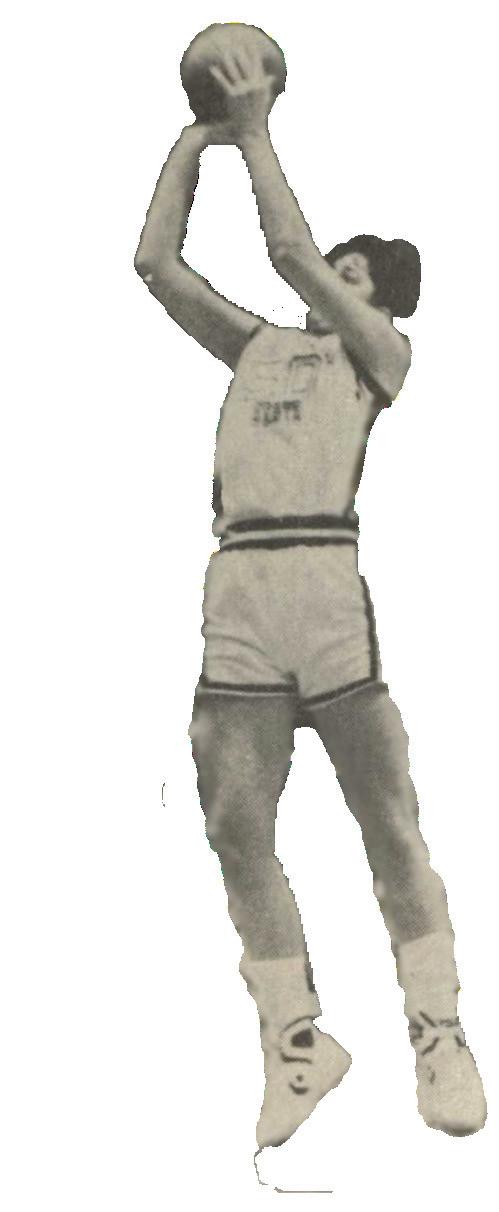
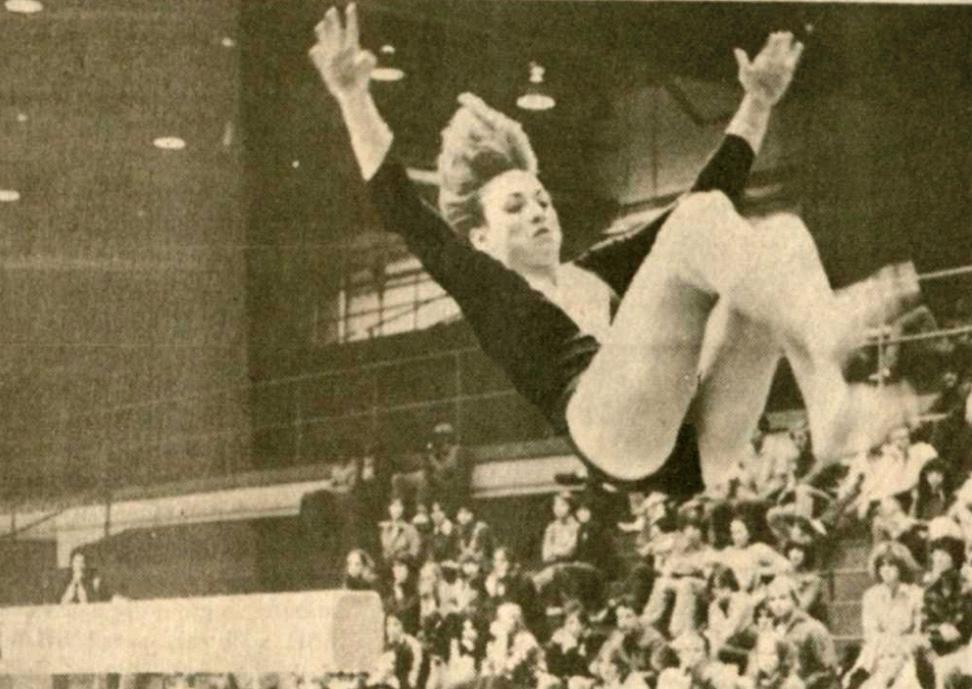
17
Photo of a field hockey match by Alyson Nussear for The Appalachian Sept. 23, 1982
Michelle Driscoll comes off balance beam with a hair-raising, heart-stopping finish in Georgia meet Friday. Photo by Howard Katz for The Appalachian Dec. 5, 1978.
Women’s basketball player Kim Johnson. Photo originally published in the Dec. 1,1988 issue of The Appalachian.
sports |
Leah’s Lens: Women should own their reproductive rights - period.
Leah Boone | Opinion Editor
In June 2022, women lost the right to their own bodies. In a single day, women felt incomparable fear as they heard the news that Roe v. Wade was overturned in a 5-4 vote. Since then, 21 states have banned abortions, with many states right behind with strict limits on abortion.
Regardless of how many U.S. residents continue to claim that banning abortion is a pro-life sentiment, the Supreme Court decision is ultimately putting more women at risk of health crises.

healthcare. Research has shown that around 20% of counties in the U.S. are over a 30-minute drive from a hospital. This in and of itself is an appalling statistic, but becomes much more terrifying when thinking about it from the perspective of a woman in labor. Since the Supreme Court decision was made, reproductive healthcare deserts have become more prominent, therefore putting thousands of women’s lives at risk.
Many cities had already fallen victim to healthcare deserts, but the overruling of Roe v. Wade overall increased the amount of women without access to reproductive
Almost 3% of women within the reproductive age group live in places with no abortion or maternity care access. This may seem like a small percentage, but it turns out to be almost 2 million women. This is absolutely inexcusable and could easily increase the statistic of women dying
due to pregnancy complications. There has already been research done regarding the increase of death in areas where abortion is banned; the number of deaths increases by 24%. The statistic is even higher for Black women, with an increase of 39%. If those who ruled in favor of overturning Roe v. Wade were actually concerned about saving lives, they would spend more time worrying about mothers that are ultimately dying because of their decision and less time worrying about a fetus who cannot feel pain.
Reproductive healthcare deserts are often in conjunction with contraceptive deserts; almost 20 million women live in areas where they do not have access to birth control, and a lot of these areas are
in states where abortion is illegal. These millions of women have little to no jurisdiction over their bodies, something that women who live in the U.S. are far too familiar with and something some men will never understand.
Healthcare deserts are extremely dangerous for everyone who lives within one, and contraceptive healthcare deserts could easily turn out to be the straw that broke the camel’s back; in this instance, the point at which all women are in exponentially more danger.
Contraceptive methods serve more than just the purpose of catalyzing safe sex; they can lessen the risk of ovarian cancer, reduce cramps during the menstrual cycle and decrease risks of other diseases. However, it is also important to note that contraceptive methods do play a large role in safe sex.
OPINION: Pink tax keeps sexism alive
Bella Lantz | Associate Opinion Editor
Many people reading this article may already know what the pink tax is.
For those who do not, mainly the male population, the pink tax refers to the different prices on items targeting a specific gender. Many times, women’s products are priced higher than their identical male counterparts.
The reason it is called the pink tax is because many times, the only difference between male or female products is that the women’s product is pink. Pink tax should not exist and yet

of women. The pink tax should disappear if the U.S. wants to continue shouting women and men are treated equally.
Some people reading this article may want to defend the pink tax, claiming it is a tax that goes to the government and improves public spaces; they would be incredibly wrong. In fact, the pink tax does nothing to aid the government because it’s not a tax at all. Every additional cent female-marketed products are charged compared to men’s products goes straight back into the company that originally set the price.
In 2021, there were over 450 male CEOs and only 41 female CEOs according to Fortune. With this statistic in mind, it is not surprising that within the beauty industry, close to two/thirds of executives are men.
This explains why there is a price
increase on women’s products. With the beauty industry being dominated by men but targeted toward women, it is interesting to think about how many of those men are raising the prices for women without realizing the impact it has.
The pink tax is not only something that concerns women’s rights, but also financial status. The term pink tax was coined in the 1990s, when it was discovered women paid around $1,351 more per year for the same products men received. With inflation taken into account, women paid around $2,300 more per year. More recently, in 2020, the California Senate Committee on Judiciary and Senate Select Committee on Women, Work & Families found that every year, women in California paid more than $2,381 for the same items as men. This is infuriating, but makes it worse when women’s basic hygiene products are considered luxury items.
In places where reproductive care, maternal care and contraceptive methods are severely limited, the following chain of events could easily occur: a woman becomes pregnant without wanting to, does not have access to the proper maternal care and cannot ensure she has a safe pregnancy.
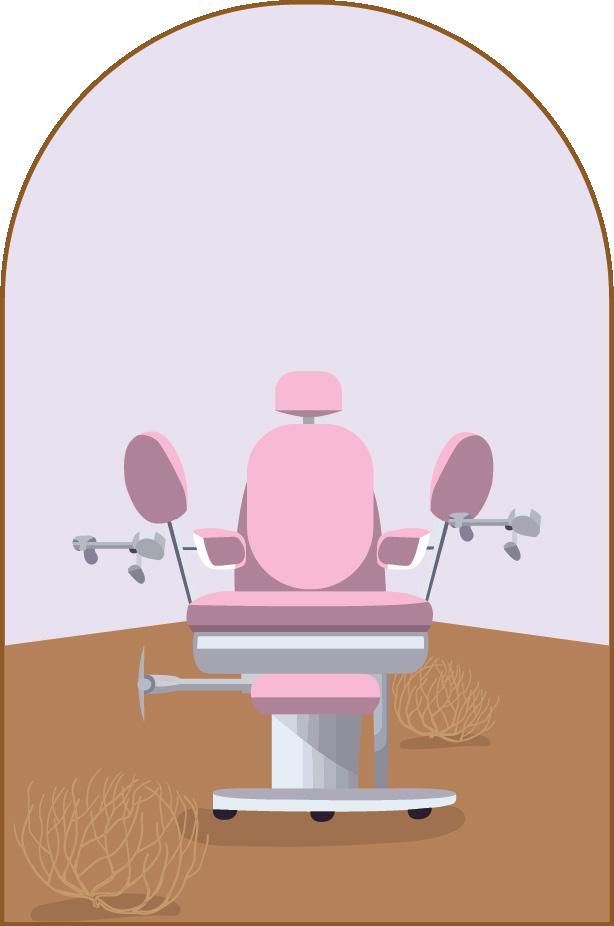

Currently, there are 21 states where women are still paying sales tax on feminine hygiene products, such as pads and tampons, because they are not considered necessity items to the government. North Carolina is one of the states that still taxes menstrual products, creating the question of what products are considered necessary to become tax exempted?
It would have to be a rigorous process to make it onto the tax exempt list. Certainly tickets to several professional sports games, chainsaws priced at over $100 or, the best one, barbecue sunflower seeds are reasonable to be tax exempted, at least according to the respective states. What has the U.S. come to in order to put these types of items over the needs of women who are having to spend so much more money than men?
The amount of money women have to spend because of the pink tax would still be unfair, but slightly more
bearable if not for the pay difference. By adding taxes to necessary items for women or increasing the cost of women’s items, it severely decreases the amount of money women have to spend on other items. On average, women are paid around 83.7% of what men are paid.
So on top of having to pay more for items, they are also paid less in the workforce. It is ludicrous that women are told the pink tax only adds around $2 here and there, and it does not make much of a difference at the end of the day.
The pink tax continues to prove time and time again that the world was initially built around men, not women. Anything involving women can be charged so much more, from razors to haircuts to anything pink; the pink tax exposes the sexism and blatant patriarchy that is currently in place.
18
Online:
Read more
Pound
Graphic by Gracean Ratliff
Chloe
more Online: | opinion
Read
OPINION: Is 2024 fashion fab or a flop?
Allison Lehan | Opinion Writer
These days, fashion trends seem to circulate throughout society more rapidly than they have in previous years. With popular social media apps like TikTok and Instagram’s user bases expanding exponentially by the day, it is no surprise that areas of selfexpression like fashion have developed a wide variety of niche communities, which contribute to the speed increase in trend cycles. Trends are constantly evolving and often look very different from year to year, and 2024 is no exception to these fluctuations, for better and for worse.
This year has already seen numerous patterns in everyday fashion through specific items and styles — some revivals of past popularity and some entirely new — but not all necessarily good. Some trends should stick around long enough to see future years, while others will hopefully see the end of their time much sooner.
The following are some of 2024’s more memorable fashion trends so far. Are they fab, or are they flops?
Upcycling one’s own clothing has always been a preferred plan of action as opposed to disposing of old items no longer worn, and with offthe-shoulder looks coming back into fashion in recent years, people have begun to get creative. The rise of the raw-neckline has taken t-shirt owners everywhere by storm in 2024 and with luck, it is here to stay.
Open necklines are extremely flattering and can be experimented with by being angled to fall off the shoulder if cut right. A slouchy, wide neckline can be achieved in just a few minutes with a pair of scissors, and the raw edge that results from this DIY applies an effortlessly casual touch to an otherwise uninteresting top.
Sometimes the stiff, ribbed collars on shirts and sweaters can feel confining. By trimming a few inches off of your old shirts, you can free those collar bones while simultaneously keeping up with fashion trends and practicing sustainability. Wins all around. Try not to get too scissor happy though. Some
things should probably be spared.
The same, perhaps, cannot be said for a pairing circulating throughout certain style niches in recent months.
One should always be a proponent of bold fashion configurations, but dresses and skirts should never find themselves draped over a pair of jeans — ever. It did not catch on when Ashley Tisdale tried it back in the 2000s, and society should still strive to perpetuate that fact today.
Jeans and dresses are fantastic pieces independently, but the moment the two touch, all previous credibility goes out the window.
Denim is a classic and distinct material — stiff and imposing — and dresses are characteristically delicate and substantial in length. They compete for one another’s attention and never quite seem to work together when part of the same outfit. While layering textures and colors, not conventionally coupled, to create dynamic outfits is never a style technique to be sneezed at, there are certainly ways in which it can be taken too far.
If this pairing is your jam, then more power to you, but generally, try and isolate this choice to the Disney Channel Original Movies.
That is not to say all trends from the 2000s era should be denounced, though. The decade had some seriously memorable fashion flops, but a few gems of the time have made valiant comebacks; namely, low-rise pants.
These pants have been quite controversial amongst fashion communities since the decline of their early 21st-century popularity, but one should not be too quick to criticize their return. Some argue the iconic garment’s distinct lack of fabric is impractical and uncomfortable — a valid argument — but they work fluently with longer shirts without bunching up against ascending waistlines and tend to be more flattering with tighter tops, given their more revealing nature.
In the latter years of the century so
far, high-waisted pants have dominated fashion preferences, but it appears as though people are on the search for a change in waist height once again. Both styles can and should be appreciated in their own right without being pitted against each other. There is no right or wrong when it comes to which length you prefer — unless you like mid-rise — but that is another story entirely.
A similarly controversial yet increasingly prolific name-brand item that can frequently be seen out and about are fur-lined Crocs. These slipons have been staples on shoe store shelves for years now; however, in 2024 they seem to be experiencing an acute increase in popularity.
Appearing in online style articles since late 2023, fuzzy Crocs have undergone a considerable return in casual fashion, but many argue the cozy clogs need to be put to rest, and they might be right.
Crocs are traditionally lightweight rubber shoes, ideal for warmer temperatures and summertime activity. A popular choice for beach-goers and children, all logical reasoning for the shoe’s existence is stripped away when altered to suit wintertime conditions.
Fur-lined Crocs are absent from their iconic holes, save for the ones on the face of the clog which are purely decorative. The fur makes them difficult to clean and because part of the allure of fur-lined Crocs is to wear them independent of socks as one does with traditional slippers, they do not quite deliver the warmth they appear to at face value.
They are entirely impractical and arguably tacky.
Let’s keep these plastic clogs free from their furry counterparts and
enjoy the classic Crocs for what they are.
Whether you wear fuzzy Crocs or dresses with jeans, keep in mind expression is limitless and entirely up to the individual.
Fashion favorites and flops of 2024 should ultimately be exercised within the bounds of acceptance, and one should always be conscious of how perceptions are affected by the limitations of conventionality. The
most wonderful aspect of fashion is the immense amount of choice diversity we can explore within it. Dress in a way that makes your heart happy.

Graphic by Rian Hughes




19
SCAN HERE SUBMIT BY APRIL 14
opinion |

20
Graphics by Brianna Bryson









 Adrianna Rice | News Reporter
Adrianna Rice | News Reporter



















 Graphics by Brianna Bryson
Graphics by Brianna Bryson












































